
When contacting us by e-mail, correspondents are asked to include their name and full postal address and, when providing information, to quote exact book and magazine sources. The word ‘chess’ needs to appear in the subject-line or in the message itself.
| First column | << previous | Archives [22] | next >> | Current column |

This well-known position (White to move) is often presented as a composition by Steinitz and misdated. For example, on page 130 of American Chess Art (New York and London, 1975) Walter Korn gave the source as ‘The Pawn March 1910’ and ‘First published in Nuova Rivista degli Scacchi 1880’.
We note, however, that the position appeared on page 247 of the July-August 1862 Deutsche Schachzeitung, as an over-the-board victory against an unnamed opponent (‘Aus einer Partie von Steinitz’).
The magazine reverted to the ending on page 53 of its February 1863 issue, stating that White can force mate in, at most, ten moves (1 h7+ Kg7 2 h8(Q)+ Kxh8 3 Kf7 Rf1+ 4 Bf6+ Rxf6+ 5 Kxf6 Kg8 6 g7 Kh7 7 Kf7 Kh6 8 g8(Q) Kh5 9 Qg3 Kh6 10 Qh4) but not indicating how much of this happened over the board.
C.N. 4333 discussed a 1920 ‘coincidence’ from the problem world involving, among other composers, J.F. Stimson. Another curious episode from the same year was recounted by, for instance, Walter Korn on page 15 of Chess Review, January 1964:
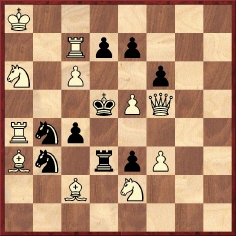
White mates in two moves.
‘The above position has two composers, A.J. Fink in San Francisco and Ua Tane of Tahiti, in a curious simultaneous experience: one dreaming the position, the other the key.
Ua Tane (“Mr” Ua, a Polynesian name given to the American composer James F. Stimson) believed there was thought transference at work due to the operations of a friend, an amateur medium, who was shown the idea of the problem.
The problem, as related by Brian Harley in his Mate in Two Moves, is one of the finest known expositions of the self-block theme. But a rationale of the alleged mustique [sic] is still lacking (Kenneth S. Howard in his The Enjoyment of Chess Problems only quotes the twin composers without any mention of that mystique.)
The problem appeared in the Good Companion Folder, July 1920.
The key is 1 Rc8; and Black’s eight self-blocking moves are: 1...Nxc6; 1...dxc6; 1...d6; 1...e6; 1...fxe5; 1...Rd4; 1...Nd4 and 1...Nc5.’
On pages 205-206 of America’s Chess Heritage (New York, 1978) Korn went into more detail, quoting from page 60 of Harley’s above-mentioned book the following passage, whose phrasing is disconcertingly similar to what appeared under Korn’s own name in Chess Review:
‘The following position is without doubt the finest known exposition of the [self-block] theme. The two composers, living as far apart as San Francisco and Tahiti, had a curious simultaneous experience, one dreaming the position and the other the key; Ua Tane (“Mr” Ua, the name given by the natives to James F. Stimson) believes there was thought-transference at work, due to the operations of a friend, an amateur medium, who was shown the idea of the problem.’
Korn added:
‘According to Harley, whom I met after the War somewhere near Portsmouth, England, he apparently had written to Ua Tane for confirmation regarding the role of the medium.’
Michael McDowell (Westcliff-on-sea, England) writes:
‘This was a case of composers working together on the same idea, exchanging matrices and gradually working their way towards a perfect setting. As regards the problem itself, the term masterpiece is justified. Eight self-blocks in a two-mover has never been exceeded, and to achieve it in a mutate setting (every black move has a mate set before the key, and the waiting key changes the mate after 1…Nxc6 from 2 Rxd7 to 2 Nc7 – there is also a less interesting change after 1…dxc6) with completely accurate play (i.e. no dual mates) adds perfect form to the task. What to make of the “supernatural” aspect of the story is entirely up to the individual, but Korn was amiss in not mentioning that the two composers were in touch by post.’
Our correspondent draws attention to the account on pages 96-97 of The Good Companion Two-Mover by George Hume and Alain C. White (the 1922 volume in the latter’s Christmas series):
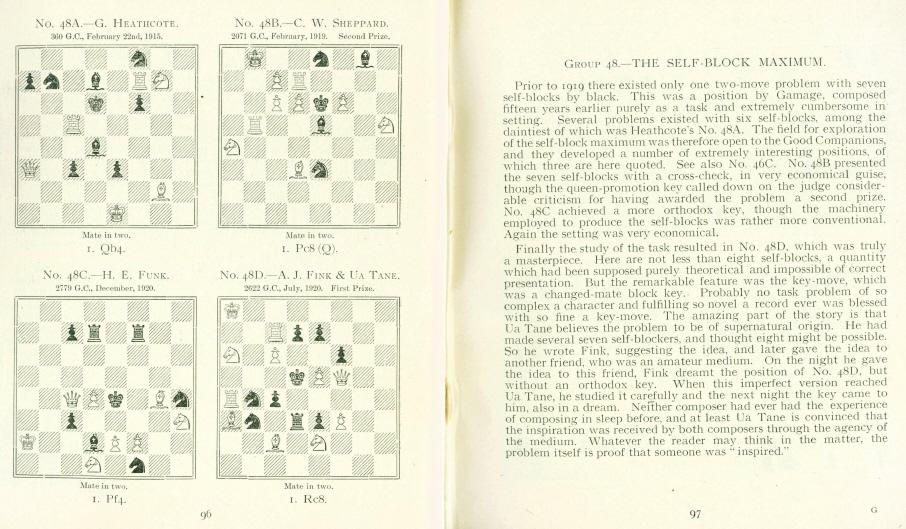
A picture of Fink (with Capablanca) was given in C.N. 3594. Here we add a photograph of ‘Ua Tane’ from page 65 of “Our Folder” (the Good Companion Chess Problem Club), 1 December 1920:
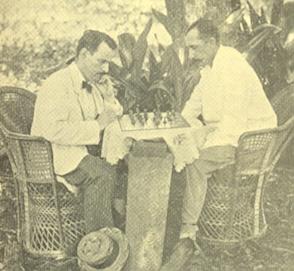
‘Our local vice-president Ua Tane and star local solver Harry L. Owen (right)’
We now have three feature articles listing various earliest sightings currently known: Chessy Words, Earliest Occurrences of Chess Terms and Unusual Chess Words. Much work remains to be done, and readers are invited to make proposals concerning existing entries and for new ones. For example, suggestions will be appreciated for the first appearance of the exact terms ‘world [chess] champion’ and ‘[chess] champion of the world’.
What is the origin of the chess term ‘cook’? The following is the current entry for the noun in the Oxford English Dictionary:
‘Chess. An unforeseen second solution that spoils a problem, position, etc.
1875 S.H. THOMAS in Westm. Papers VII. 243, I almost imagined the author’s solution a “cook”. 1876 W. NASH Ibid. IX. 53 If this is not a cook the problem is much under the composer’s usually high standard. 1894 Daily News 30 July 6/7 The latest delinquent is the composer of problem No. 55, whose intention was to mate by 1 Q-Kt4, overlooking the easy cook by 1 QxKt. 1966 New Statesman 24 June 941/2 Veitch found the otherwise beautiful piece blemished by this cook.’
And the chess-related entry for the verb:
‘To ruin, spoil, “do for”. slang.
1889 Field 14 Dec. 854 [Chess] If there are two key-moves, a problem is cooked.’
Below we quote some discussion in chess literature about the word’s uncertain origin, beginning with a piece on pages 124-125 of the Chess Weekly, 19 September 1908:
‘The Manchester City News denies that Kling, the endgame composer, made use of the word “cook” to convey the meaning that a chess problem had proven unsound. Herr Kling’s claim as the inventor of the term rests on the testimony of Blackburne, who has given 1863 (or thereabouts) as the time when he heard Kling use the word. The News says that in September 1858 a young problemist showed a position of his own making to Mr H.E. Bird, who saw the solution in a minute or two. Duly moving the pieces, Mr Bird said, “That’s one way.” Thereupon Samuel Boden exclaimed, “Cook it, Bird.” Mr Bird continued to move the pieces and said at last, “There is no cook that I can see.” The young composer timidly asked, “What is a cook?” Mr Bird and Mr Boden both laughed. Then Mr Boden said, “Cook is a word for an unsound problem. In the cookery books, you know, there are pages of different recipes for cooking the same dish. Each recipe is headed, ‘Another Way’.” Thus the word was used five years before Blackburne heard it from the lips of Herr Kling. From the Melbourne Australasian.
But why did Mr Bird move the pieces?’

Josef Kling (left) with Frank Healey
A rather less gossipy article entitled ‘The Origin of the Problem Term “Cook”’ in the Cheltenham Chronicle (whose chess editor was W.S. Branch) was reproduced on page 197 of the April 1922 Chess Amateur. Below is the full text:
‘There are two theories, and probably one of them is correct, but no-one can prove which. The term was not widely used before 1870, and later than that date was considered by some chess editors to be a bit of “slang” which they were too dignified to use. And it may have come from a slang expression in use 70 to 100 years ago, and still heard occasionally.
We are reminded of this question – no great matter in itself, but a question which is constantly being asked by players, who have had little or nothing to do with problems, who hear some solver use the word “cook”, and the solvers, as a general rule, can give no answer at all – by receiving from a correspondent a printed cutting, as follows:
“Herr Kling, a well-known endgame composer, kept an eating-house in London about 80 [sic] years ago, and his friend Herr Horwitz, a chess master, used to take what he described as a ‘raw idea’ to him. ‘Oh, I will cook your raw idea’, exclaimed Kling, meaning that he would find a solution differing from that of the author. Hence the term.”
This is the most popular explanation, and the actual statement may be true. Kling very likely used those words. But he may have had quite a different meaning. In cooking things he improved them – made them suitable for consumption. Being a better composer than Horwitz, in endgames and problems, he worked up and improved his friend’s “raw ideas”, and many of them were published as by Kling and Horwitz. This hardly explains the origin of the term “cook” as used for the past 60 years or more. We do not consider a problem improved by being “cooked”.
The other theory, which the present writer thinks more probable, is that the term came into use among chessists about 1845, mostly in London for a long time, from the slang expression “cooking his goose” meaning “to spoil his game” or frustrate his object. This would agree with the present and long-established meaning of the terms “cook”, “a cook”, “several cooks”. Murray’s History of Chess does not refer to the matter, or even to Kling, and to Horwitz only as a player. It may be that Kling’s use of the word, in the sense of improving or working up, was repeated to others, who later applied it in the “cook his goose” sense – the discovery of unsoundness, or of a second solution, not known to the author, something that made the problem worthless. Strictly speaking, a problem with any number of solutions is “sound” in the ordinary meaning of the word, not confined to chess problems. The condition “mate in – moves” is fulfilled. But a chess problem with more than one solution is unsound artistically. The composer intends but one solution, and if another is demonstrated the discoverer has “cooked his goose”. Also, if he can prove that there is no solution at all though the term “cook” is rarely used in this connection now. It has become a technical term for a second solution or any not intended by the composer.’
On page 226 of the May 1922 Chess Amateur John Keeble expressed doubt:
‘... As far as chess is concerned the term originated with Messrs Kling and Horwitz. In 1851 they edited a magazine called the Chess Player, and in volume 1, No. 5, 15 August 1851 appeared the following:
“Mr Alexander’s collection of two thousand problems contains many faulty positions, and we shall now and then cook some of them, which may amuse you and many of our readers.”
In fulfilment of this promise we find in the issue of 25 October 1851 a number of “corrected problems from Alexander’s collection”.
Now it is clear from this that Kling and Horwitz, by “cook”, meant to perfect or make sound, which is the opposite of to spoil or frustrate. In 1862 Mr Blackburne was a chess pupil of Horwitz at Manchester, and shortly afterwards came into touch with Herr Kling in London. From both he heard the tale of “raw ideas” and “cooking”, which he never forgot, and I think it can be made clear that the modern meaning of the word is due to the use Mr Blackburne has made of it. I believe he claims it to be so.
I do not know of any printed reference to the term, after 1851, until 1870. In Illustrated London News, 6 August 1870, there is the following reply to a correspondent:
“Cranmore – Very smart.” “Is it a true story”, as Audrey asked, or have you only conveyed and cooked it? We have a strong reminiscence of a position founded on the same idea, though the mate was not effected in so few moves.”
Perhaps the first distinct reference to “cook” in its modern sense appears in Westminster Papers, 1 April 1875. S.H. Thomas says, “So faulty with duals that I almost imagined the author’s solution a ‘cook’.” From that date the term, both as noun and verb, occurs frequently.’
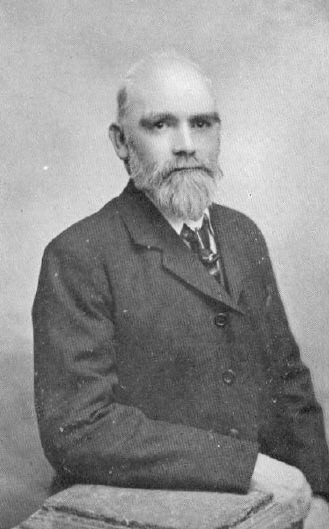
John Keeble
On page 2 of the October 1922 Chess Amateur Keeble provided an addendum:
‘... I have now found another early reference to it. In 1855 Professor Charles Tomlinson wrote a chess tale, entitled “The Promissory Note”, which was first published in his Chess-Player’s Annual of 1856. A description of a short game in it was concluded with the following dialogue:
“The stranger then rose from his seat, announced mate in six moves, and stalked out of the room.
While I was trying, in my confusion, to solve the problem thus placed at my disposal, little Blunt came up to know who was my opponent, and whether I had won the game. ‘Mate in six’, sighed I.
‘Mate in six! Nonsense man. Give us a cigar, and let us look it over. Well, to be sure, it looks bad enough’, he continued, lighting one of my cigars; and after puffing away for a few minutes he decided my fate in the elegant exclamation, ‘Cooked, by Jove. How could you get into such a mess?’”
It is not quite clear that “cooked” here refers to the player or the position, but anyhow it has a distinct connection with a problem at chess.’
A further contribution to the subject by Keeble was published on page 214 of the June 1930 BCM:
‘As regards E.B. Cook [born on 19 May 1830] it might be mentioned that the Americans claim that his name originated the term “cook”, as a second solution to a chess problem, but this is not correct. E.B. Cook was an expert solver, but the term “cook” came from Kling and Horwitz and is mentioned by them in the Chess Player of 1851 – 79 years ago. They meant it to mean putting an unsound problem right. Our late beloved master, J.H. Blackburne, had a good deal to do with putting it the other way. He told me this himself.’
Exclamation marks became prevalent in the Deutsche Schachzeitung in 1861, but at first the custom was to attach them to moves by Black in compositions, in the sense of ‘the best defensive try’. See, for instance, page 136 of the April 1861 issue. Another example concerns this position from page 70 of the January 1861 number:
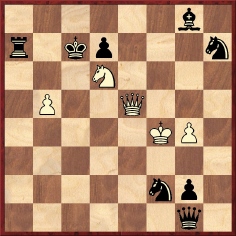
The solution appeared on page 228 of the July 1861 Deutsche Schachzeitung:
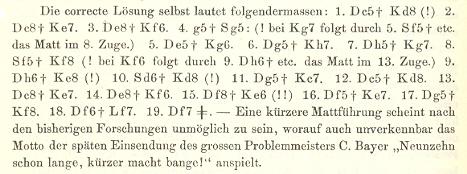
As regards the general use of exclamation marks, we recall the following remark by Harry Golombek in a review of Schachgenie Aljechin by H. Müller and A. Pawelczak on pages 160-161 of the May 1954 BCM:
‘Müller is the type of commentator who labours under the erroneous impression that a plain statement can be made to appear colourful and even original by the addition of one or more exclamation marks and in consequence this book is unnecessarily burdened with some thousands of these superfluous signs.’
From the review mentioned in the previous item we also quote this comment by Golombek:
‘... [Pawelczak’s] categoric statement on page 52 that “Aljechin war ein ausgezeichneter Bridgespieler” (Alekhine was an excellent bridge player) is quite false. I played quite a lot of bridge with Alekhine in 1939 in South America and, even by my modest standards, Alekhine was a very weak bridge player. I well remember his wife remarking to him, after he had made some particularly atrocious mistake, “If you go on like this you’ll lose us our château in France”.’
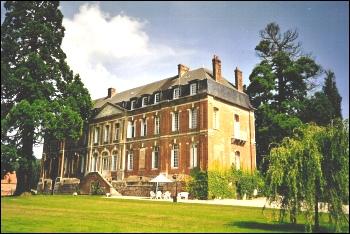
Alekhine’s château in St Aubin-le-Cauf (near Dieppe), France is now owned by Agnès and Jean-Pierre Bosselin. Their daughter, Véronique Perrin-Bosselin, has written to us as follows:
‘We are very interested in the illustrious former owner of our property and in providing information to our guests about its history. My grandfather acquired the castle from Madame Alekhine after the War. It had been completely looted during the evacuation and was then used by the German Army, which converted it into a hospital. A few years ago my parents transformed the château into guest rooms and reception halls, and all the bedrooms naturally have names with a chess theme. In addition to rooms named after chess pieces (rook, knight, king and queen), there is an Alekhine Room.
The château would be available for any kind of special event related to chess.’
A number of C.N. items have discussed the chessplayer and astronomer E.M. Antoniadi (1870-1944). See, in particular, the account on pages 150-153 of Chess Facts and Fables and, for two further photographs of him, C.N. 3903. Now we give a victory with his own annotations, translated from pages 66-67 of L’Echiquier Français, July-August 1909. It was a casual game played at the Café de la Régence.
A. Silbert – Eugène-Michel Antoniadi(Notes by E.M. Antoniadi)
1 e4 e5 2 Nf3 Nf6 3 Nxe5 d6 4 Nf3 Nxe4 5 d3 Nf6 6 d4 d5 7 Bd3 Bd6 8 h3 (‘A loss of time. Castling would have been preferable.’) 8...O-O 9 O-O Nc6 10 c3 (‘White’s play is too defensive.’) 10...Ne4 11 Re1 f5 12 Nbd2 Be6 13 Nf1 Qf6 14 N3h2 Rae8 (‘Black has now mobilized all his forces and has an excellent game, having gained at least three tempi in development.’) 15 f4 Qh4 (‘Pointless, as the queen cannot give check on f2 without incurring danger. White now gains a little ground.’) 16 Nf3 Qh6 17 Ne5 Bxe5 18 fxe5 Qg6 19 Qf3 Nd8 (‘The idea of putting this knight on e6 and the bishop on d7 is a good one.’) 20 Bf4 Bd7 21 Kh2 Ne6 22 Rac1 c5 (‘The start of a strong attack.’) 23 Be3 f4 (‘White’s forces are now driven back in disarray in the centre and on the king’s side, and Black remains master of the situation.’) 24 Bg1 (‘This cuts off the white king’s retreat.’) 24...N6g5
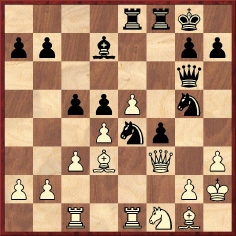
25 Qd1 (‘If 25 Qe2 then 25...f3 26 Bxe4 dxe4 27 Qf2 fxg2 28 Qxg2 Bxh3, or 28...Nf3+, with a won game; or 26...fxe2 27 Bxg6 exf1(N)+ 28 Rxf1 hxg6, and Black is a piece ahead. It is evident that if 25 Qe2 f3 26 gxf3, then 26...Nxf3+, followed by mate in a few moves.’) 25...Qh6! (‘With the idea of sacrificing a piece on h3, a combination against which there is no defence.’) 26 Bxe4 Nxh3 27 White resigns.
Jack O’Keefe (Ann Arbor, MI, USA) submits the following picture, from page 9 of the April 1945 Chess Review:

‘On the sidelines, Marcella Powers
of Good Housekeeping Magazine plays a friendly game
with Corp. Frank Marshall Jr., recently returned from combat
service in France, as Sinclair Lewis looks on.’
In C.N. 4091 a correspondent raised the subject of this painting (Maximilian Mopp’s ‘Chess with Emanuel Lasker’):
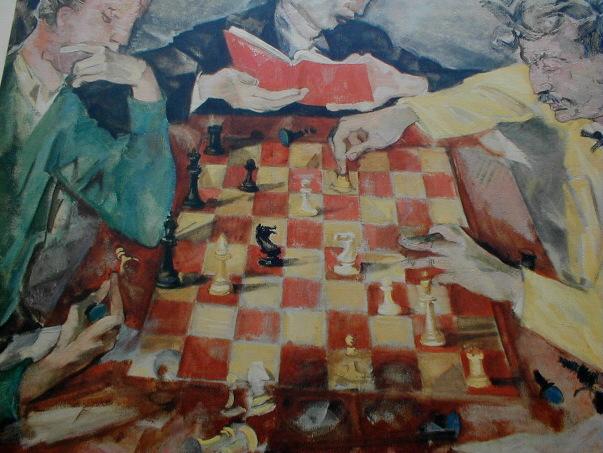
Now Jack O’Keefe sends us a copy of the dust-jacket of the first edition of Chess for Fun & Chess for Blood by Edward Lasker (Philadelphia, 1942):
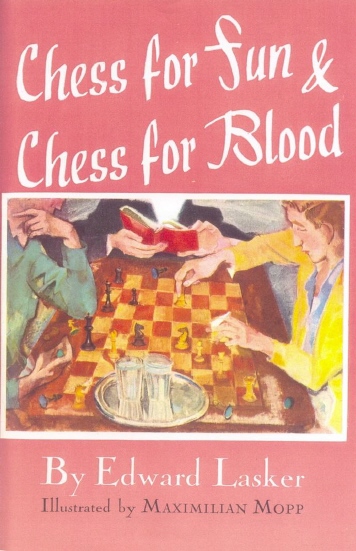
A story which Irving Chernev was fond of telling:
‘In 1850 an old passion for chess awoke in Szechenyi (founder of the Magyar Academy) and took an insane character. It became necessary to pay a poor student to play with him for 10 or 12 hours at a time.
Szechenyi slowly regained his sanity, but the unfortunate student went mad.’
That appeared on page 40 of Chernev’s book Wonders and Curiosities of Chess (New York, 1974), and a similar version (‘The unfortunate student went mad, but Szechenyi slowly became sane’) was given by him on page 14 of Chessworld, January-February 1964 and on page 56 of Curious Chess Facts (New York, 1937).
In Curious Chess Facts he gave a source: ‘Lombroso in The Man of Genius’. Does any reader know what that book contained regarding Szechenyi and chess?
A further group photograph including William Winter (at Canterbury, 1930) was published on page 205 of the June 1930 BCM:
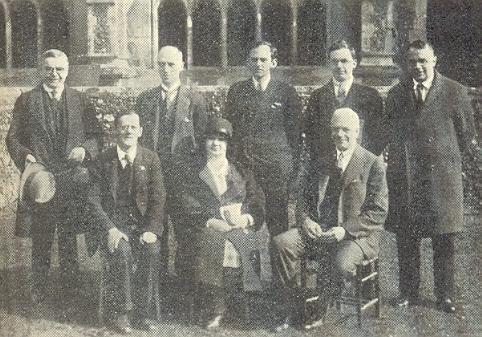
Standing (left to right):
H.E. Price, E. Spencer, W. Winter, G. Abrahams, A. Seitz
Seated: F.D. Yates, V. Menchik, Sir George Thomas
The task in C.N. 4336 was to name any players who, when barely into their teens, had already had two chess books dedicated to them.
We can think of only one person:
Rob Bijpost (Middenmeer, the Netherlands) sends us a photograph taken by him of Daniël Noteboom’s grave in the public cemetery in Noordwijk:
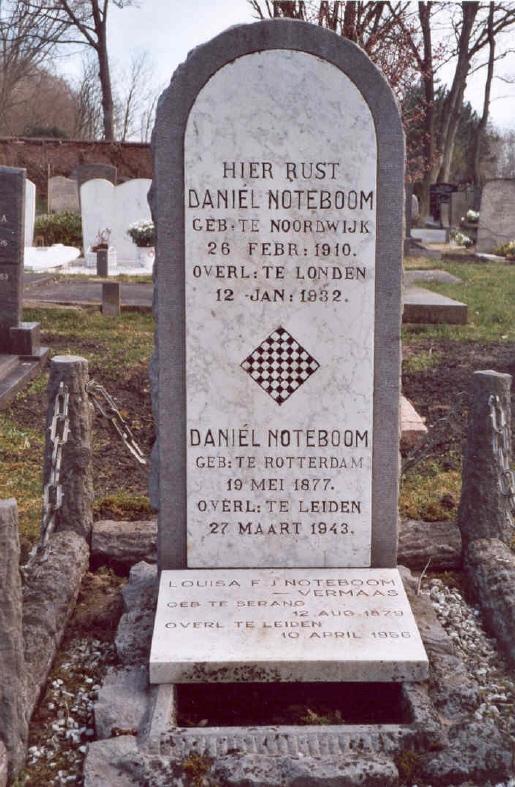
We recall in this connection the following item on page 239 of the August-September 1933 Tijdschrift van den Nederlandschen Schaakbond:
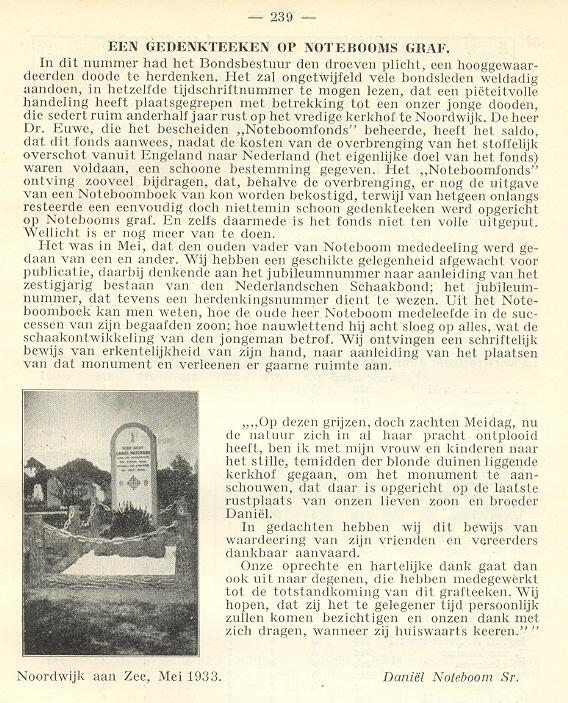
Below is the title page and frontispiece of Max Euwe’s monograph on Noteboom, which included 30 of the latter’s best games:
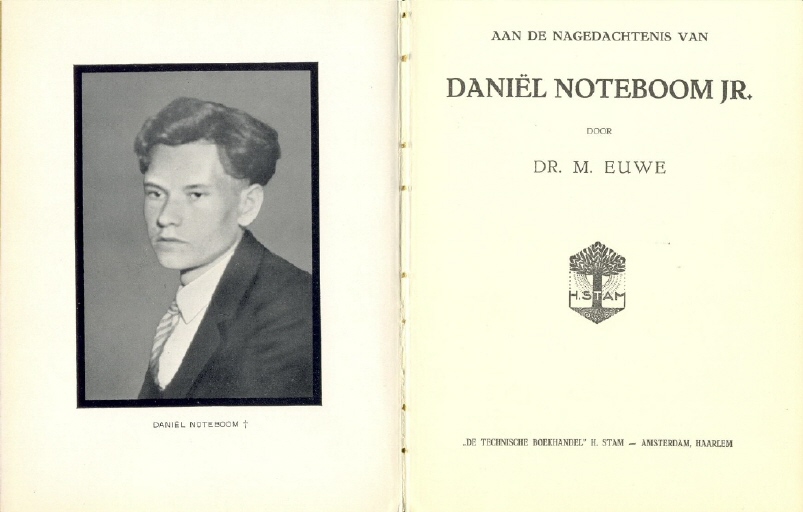
A less well-known photograph of Noteboom was published on page 56 of Kagans Neueste Schachnachrichten, March 1932:
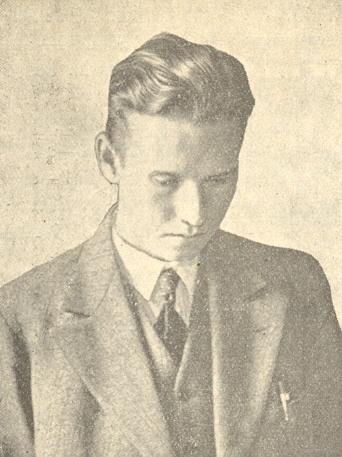

Adolf Anderssen
Exercise 344 on page 92 of Your Move! by Y. Neishtadt (London, 1990) is the following position:
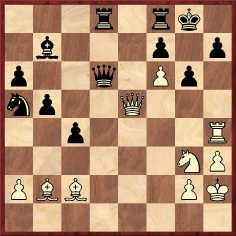
White to move.
The solution (see pages 143-145) was introduced as follows: ‘White in this game was Anderssen, who had given his pupil Zukertort a rook (Breslau 1862).’ Neishtadt recorded that Anderssen managed to draw by 1 Qg5 Qd2 2 Nf5 Qxg5 3 Ne7+ Kh8 4 Nxg6+ Qxg6 5 Bxg6 Rd2 6 Rxh7+ Kg8 7 Rg7+ and he added:
‘For more than a century Anderssen’s combination was regarded as the only way to avoid defeat. But recently the Soviet player M. Kim discovered that Anderssen could have won by beginning the combination with a bishop sacrifice: 1 Bxg6!!’
The book then provided analysis to show that Black’s four possible replies (1...hxg6, ...fxg6, ...Qxe5 and ...h6) all lost.
Neishtadt did not specify where M. Kim published his analysis, but it should be noted that the move 1 Bxg6 was pointed out by Alekhine in the 1930s.
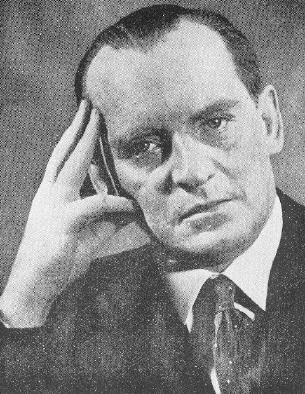
Alexander Alekhine
The above position was published on page 154 of Les Cahiers de l’Echiquier Français, September-October 1933, where readers were asked whether White, with a strong attack on the castled king but a material deficit, could win. The magazine returned to the subject on pages 215-221 of the January-February 1934 issue, where the game was firstly mentioned as an encounter at rook odds between Anderssen and Zukertort in Breslau in February 1862, the source being Ludwig Bachmann’s monograph on Anderssen (see page 177 of the second, 1914, edition). There followed four full pages of prose discussion of the position, after which came ‘Anderssen’s solution’. This was the same drawing line as that given by Neishtadt (and Bachmann), except that the final moves in the Cahiers were a different perpetual check: 5 Bxg6 Kg8 6 Bxh7+. Then the magazine presented ‘Alekhine’s solution’ from the diagram above:
‘A few months ago the writer of these lines had the idea of showing this position to Alekhine, asking him, “What would you play in this position?”. It was during a dinner, so that the situation of the pieces was quoted from memory and the world champion had to undertake his analysis and work out his solution without seeing the board. Within a few minutes he discovered Anderssen’s combination, which is hardly surprising on the part of the holder of the [blindfold] record at Chicago, 1933. But that is not all. After a few minutes’ deep thought Alekhine proposed to us another first move and, to our wonderment, immediately set out the main variations, all of which led to victory for White.’
The main lines of Alekhine’s analysis were then given, as follows (the comments in square brackets being by us):
‘1 Bxg6!! Notwithstanding the tremendous defence of the g6-pawn by the pawns on f7 and h7. In fact, capturing the bishop is impossible.
1...Qxe5 Best. If 1...fxg6 2 f7+ Kxf7 3 Rf4+ and a quick mate. [3 Rxh7+ is faster.] If 1...hxg6 then 2 Qg5 (with the double threat of 3 Qh6 and 3 Rh8+) 2...Qd2 3 Nf5! (with the double threat of 4 Ne7 mate and 4 Nh6+ Kh8 or Kh7 5 Nxf7+ Kg8 6 Qxg6 mate) 3...Rfe8 (best) 4 Ne7+ Rxe7 5 Rh8+!! Kxh8 6 fxe7+ and wins.
2 Bxh7+ The bishop could not be captured by Black, and it opens up a wider breach, seizing the g- and h-pawns; gradually the material deficit is recovered.
2...Kh8 3 Bxe5 Threatening 4 Nf5, followed by 5 Ne7 and discovered mate by the bishop.
3...Rfe8 The only move permitting Black to prolong resistance. For example, 3...Rd2 4 Be4+ Kg8 5 Nf5, etc.
4 Bc3!! A profound move. 4 Bb2 would fail as it would not oblige Black to save his attacked knight and would allow him to place a rook on d2 for a counter-attack.
4...b4 Best. Immediately retreating the knight to c6 would be insufficient.
5 Bxb4 Nc6 Saving the knight and bringing it to watch over the e7 square, but the bishop is cut off.
6 Bc3 Threatening 7 Nf5.
6...Re3 If 6...Bc8 7 Be4+ Kg8 8 Bxc6 wins.
7 Bb2! wins. For example, 7...Rd2 8 Nf5 Re8 (if 8....Rxb2 9 Nxe3) 9 Ne7! Nxe7 10 Bc2+! Kg8 11 fxe7 and wins.’
The French magazine returned to the subject on pages 347-348 of the September-October 1934 issue, firstly correcting the note to 7 Bb2 in Alekhine’s line:
‘After 7 Bb2 Rd2, 8 Nf5? is a mistake which enables Black, with 8...Ree2 (instead of 8...Re8 or 8...Rxb2 as indicated in the note), to achieve a draw through the threat of 9...Rxg2+ and perpetual check. On the other hand, after 7 Bb2 Rd2 White simply needs to play 8 Nf1! (or 8 Bc1), winning the exchange and ensuring a won endgame. Thus, as Mr Hardouin of Saint-Lô points out to us, the validity of Alekhine’s discovery is not undermined at all, since the remedy is discovered at the same time as the disease.
Mr Defosse of Brussels does not contest the viability of Alekhine’s analysis but points out to us an interesting alternative line at White’s sixth move, a line which also seems to win quickly. After 1 Bxg6 2 Qxe5 2 Bxh7+ Kh8 3 Bxe5 Rfe8 4 Bc3 b4 5 Bxb4 Nc6, instead of 6 Bc3 it is also possible to win with 6 Be4+! Kg8 7 Bxc6! Bxc6 8 Nf5! The idea is to threaten 9 Ne7+, forcing 9...Rxe7, because if 9...Kf8 10 Nxc6, taking advantage of the position of the undefended black bishop at c6 and of the valuable activeness of the white bishop on the a3-f8 diagonal. [After 9 Ne7+ Kf8 White has 10 Rh8 mate.] It does indeed appear that Black is forced to give up the exchange and another pawn, leaving White with a won endgame despite the bishops of opposite colours. Here are some variations:
A) 8...Rd3 9 Rxc4 Re4 (if 9...Bb5? 10 Ne7+ Rxe7 forced 11 fxe7 wins) 10 Ne7+ Kh7 11 Rc5! (threatening 12 Rh5 mate) 11...Kh6 or Rh4 12 Nxc6 wins.
B) 8...a5 9 Bc3 (without loss of a tempo) 9...Rd3 10 Rxc4 Bd5 11 Ne7+ Kf8 forced 12 Rh4!, followed by mate.
C) 8...Rb8 9 Bc3 Bb5 10 Ne7+ Rxe7 11 fxe7 f6 12 Bxf6 wins.
D) 8...Rd7 9 Bc3, entering a familiar variation.
E) 8...Rd5 9 Ne7+ Rxe7 10 fxe7 f5 11 Rxc4 wins.
F) 8...Bb5
9 Bf8!! (the point) 9...Re4 (if 9...Kxf8 10 Rh8 mate, and if 9...Rxf8 10 Ne7 mate; if 9....Rd4 10 Nxd4 Rxf8 11 Nf5 Re8 12 Ne7+ Rxe7 13 fxe7 wins) 10 Ne7+! Rxe7 11 Bg7 and mate by 12 Rh8.
The Defosse variation is thus a dual ... with which we are delighted. Far from marring this practical problem as if it were an artistic problem, it enriches it with all its complexity.’
The Alekhine analysis (although not the subsequent Defosse material) was given by D.J. Morgan on page 130 of the May 1957 BCM, and a prose account of Alekhine’s feat appeared on page 60 of Curious Chess Facts by Irving Chernev (New York, 1937).
Bruce Monson (Colorado Springs, CO, USA) writes:
‘I wonder if anyone can bring light to the following intriguing mystery involving Tal. In the May 1967 BCM (pages 125-127) there was an interview with him, reprinted in English from a weekly publication of the Russian Federation Writers’ Union. Tal relates a story about his encounter with a mental patient:
“I recall an incident, a tragic one, I would say. I was the world champion at that time, and a psychiatrist friend of mine, also a strong player, made the following request to me one day:
‘Misha’, he said, ‘please play a game with one of my patients, and see to it that you win absolutely.’
‘Why don’t you do it yourself?’
‘I can’t. The chap is 26 years old and thinks he’s the world’s greatest chessplayer, claiming easy victories over Chigorin and Lasker. Only a rude shock can get him out of this state of mind. That’s why I’m asking you to play with him.’
I agreed, and went over to the mental hospital. I was introduced to the young man, who repeated his story of victories over long-dead champions. He raised no objection to a game with me, and even tried to please me by removing one of his rooks, to give me an advantage. I managed to get him to agree to play on equal terms.
You can imagine how I felt when I soon realized that I was losing. And, no matter how hard I tried, I lost. The chap suggested that we play another game. You can take my word for it, the strain in this game was far greater for me than in the world title match. With tremendous effort, I succeeded in beating that fellow in the next two games. He condescendingly observed that I wasn’t such a bad player.
‘But you should have seen how Chigorin and Lasker played’, he added.
We met again three months later at a mass-scale chess competition. I recognized him and I told my friends: ‘That’s the man who’ll win today.’
‘How do you know?’, my friends asked.
‘You just wait and see’, I replied.
I decided to play with that mental hospital patient in my first game, but as soon as it started I realized that he had advanced to the second-category ranks: my psychiatrist friend had cured him after all.”
Does anyone know the identity of this mystery “mental patient”? Is there a record of any game-scores having been kept by Tal?’
The full interview also appeared on pages 120-121 of the May 1967 Chess Life. In the final sentence quoted above it had ‘shifted’, not ‘advanced’, and in the context the former word seems more logical.
What is the explanation for the following?
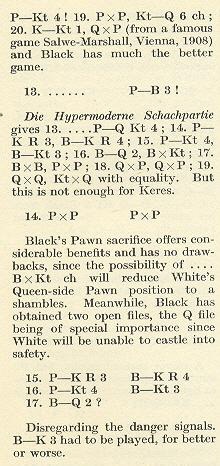
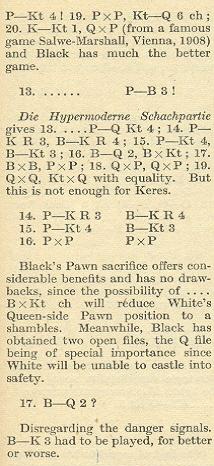
Luc Winants (Boirs, Belgium) sends us a photograph of William Winter from the collection of Daniël De Mol. It is believed to have been taken in Brussels during the Hampstead Chess Club’s tour in the summer of 1926 (a report on which appeared on pages 407-409 of the September 1926 BCM).
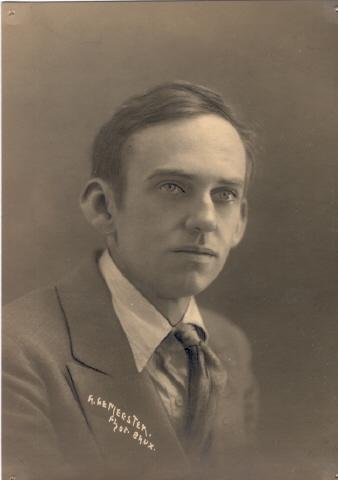
William Winter
C.N. 4016 gave the following tournament game:
Alexander Alekhine – ??1 d4 d5 2 c4 e6 3 Nf3 Nf6 4 Bg5 Bb4+ 5 Nc3 dxc4 6 e4 c5 7 Bxc4 cxd4 8 Nxd4 Qa5 9 Bxf6 Bxc3+ 10 bxc3 Qxc3+ 11 Kf1 Qxc4+ 12 Kg1 O-O 13 Qg4 g6 14 e5 Nc6
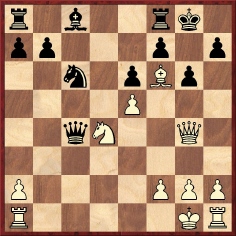
15 Nf5 Resigns.
This game was published on pages 231-233 of A. Alekhine Agony of a Chess Genius by P. Morán (Jefferson, 1989) and page 728 of Alexander Alekhine’s Chess Games, 1902-1946 by L.M. Skinner and R.G.P. Verhoeven (Jefferson, 1998). Both books identified Black as A. Muñoz, but C.N. 4016 gave a photograph which appeared to show an altogether different position in the game between Alekhine and Muñoz:
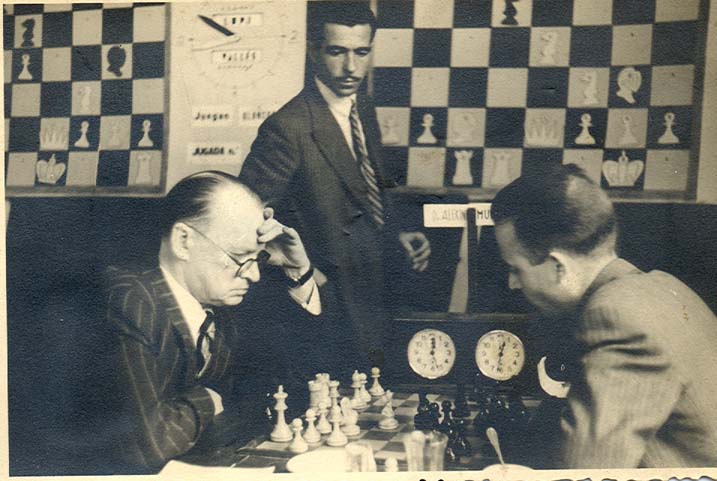
Leonard Barden (London) writes:
‘The real encounter between Alekhine and Muñoz, which must be the pictured game, looks like a French Defence with 3 Nd2/Nc3 dxe4 4 Nxe4. In his game against Julio López in a tournament at Almería later the same month Alekhine chose a rather similar formation to that shown in the photograph, and especially Bf4 with Bg3 after Black’s Nd5. The black formation in the picture is indistinct, but Muñoz has gone for ...a6 and perhaps ...Bd7 rather than the ...b6/Bb7/Re8 set-up which encouraged Alekhine’s sacrificial king’s-side attack in the López game.
Page 728 of the Skinner/Verhoeven book on Alekhine records that his game against Muñoz was played in the ninth and final round, on 10 August. Tournament photographers often turn up on the first day or the final day, so that is consistent too.
But in that case, who was the loser of the 15-mover? 14 e5 is essentially just a one-move cheapo based on Black missing the obvious Nf5 threat. If Black answers 14...h5 to give the king a flight square at h7, then 14 e5 is not very good. The database shows 14 Qf4 as the normal continuation, with Trifunović v Gligorić, Mar del Plata, 1953 as a principal example. So 14 e5 looks like the kind of move that is played in a simultaneous exhibition or, if in a tournament, against a truly weak player.
Since Mena finished eighth out of ten in Sabadell and had a name which could easily have become warped into Muñoz he might seem the most likely player to have lost the 15-move game. However, page 727 of Skinner and Verhoeven’s book records that of the four missing games Alekhine was White in all of them except the Mena one. The missing games were listed as follows:
Round two, 3 August: Mena v Alekhine
Round three, 4 August: Alekhine v Vilardebó
Round five, 6 August: Alekhine v Ros
Round seven, 8 August: Alekhine v Pérez.Assuming that the above details are correct, the question, therefore, is whether the loser of the 15-move game was Vilardebó, Ros or Pérez.’
From Joost van Winsen (Silvolde, the Netherlands):
‘I wonder if there have been tournaments which were as unhealthy as the Fourth American Chess Congress in Philadelphia, 1876. Five out of nine players were ill, or said to be. First, some annotations from the tournament book:
Page 46 (Martinez v Davidson): “If Black attempts to retain the pawn, it yields a fine attack to White, yet we cannot consider the sacrifice sound, though Mr Martinez, being ill, did not make the most of it.”
Page 49 (Roberts v Barbour): “Mr Barbour was laboring under severe indisposition when playing this game.”
Page 170 (Judd v Roberts): “An oversight which loses the game. It is but justice to Mr Roberts to state that he labored under some indisposition at this time.”
Page 173 (Roberts v Judd): “We repeat that Mr Roberts was ill during the latter part of this game, and the one previous.”
Page 178 (Ware v Mason): “It is but justice to Mr Ware to state that in his two games with Mr Mason he was laboring under a severe attack of indisposition, and, but for the delay that would have occurred through his absence, he would have kept to his house, instead of being abroad.”
Moreover, the Chicago Tribune of 17 September 1876 wrote that the second game between Mason and Judd was not played, owing to Judd’s illness. The tournament crosstable records that game as a draw.
It seems that the only contestants who managed to remain healthy in Philadelphia were Mason, Bird, Elson and Davidson. Martinez retired after four games.’
Paul Brown (Orange, CA, USA) sends the following casual game
from pages 185-186 of Deutsches Wochenschach, 23 June
1901. It appeared with notes by White, the original source being
specified as Akademische Schachblätter.
1 e4 e5 2 Nf3 Nc6 3 Bb5 a6 4 Ba4 d6 5 d4 exd4 6 Nxd4 Nge7 7 Bg5 Bd7 8 Nc3 h6 9 Be3 Nxd4 10 Bxd7+ Qxd7 11 Bxd4 Nc6 12 Nd5 O-O-O 13 O-O Qe6 14 f3 Rg8 15 c4 g5 16 Bc3 Bg7 17 Bxg7 Rxg7 18 b4 g4 19 b5 gxf3 20 Rxf3 Ne5 21 Rf2 Ng4 22 Rf4 Rdg8 23 bxa6 b5
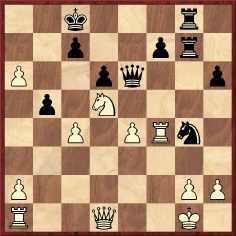
24 a7 Kb7 25 Rb1 Ne5 26 Rxb5+ Kc6 27 Rb8 Rxg2+ 28 Kh1 Rxa2 29 Qb1 Resigns.
Our correspondent points out that the identical moves (with the conclusion 29...Rg1+ 30 Qxg1 Rxa7 31 Qxa7 resigns) had occurred in an 1871 game between Johannes Minckwitz and Louis Paulsen in Crefeld (or Krefeld). See page 29 of the tournament book and pages 26-27 of the January 1872 Deutsche Schachzeitung. Mr Brown also mentions that there are similarities between the notes in the Deutsche Schachzeitung and Deutsches Wochenschach.
Pages 59-60 of Curious Chess Facts by Irving Chernev (New York, 1937) featured a familiar tale in the ‘once’ category:
‘Steinitz and Zukertort were once present at a dinner where a toast was given to the “Chess Champion of the world”. Both players stood up.’
The same story was presented on page 76 of his book Wonders and Curiosities of Chess (New York, 1974) and on page 104 of The Fireside Book of Chess (New York, 1949), which he co-authored with Fred Reinfeld.
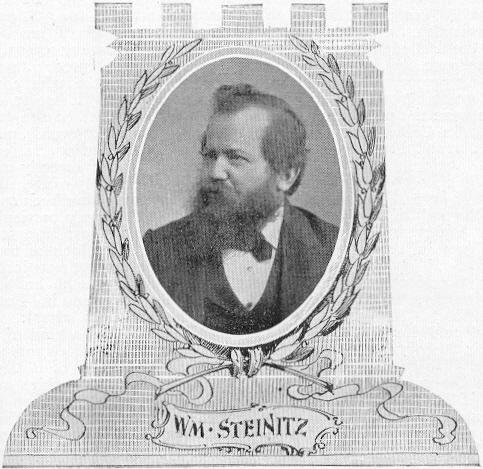
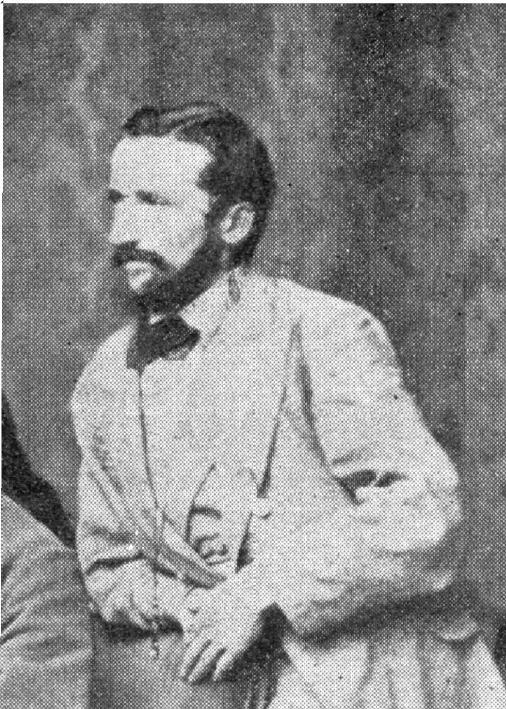
Wilhelm/William Steinitz and Johannes Hermann Zukertort
In The Great Chess Tournaments and Their Stories (Radnor, 1975) A. Soltis wrote an entire chapter on London, 1883 under the title ‘Will the Real World Champion Please Stand Up?’ (pages 21-49). The opening paragraph reads:
‘As a matter of fact there was a banquet at which a toast to the World Champion was raised, and both Wilhelm Steinitz and Johannes Zukertort stood up. But that was after London 1883, and that’s getting ahead of the story.’
Nothing else of relevance was provided, and, as so often, William Steinitz, Chess Champion by Kurt Landsberger (Jefferson, 1993) is also of little help. Page 137 states regarding London, 1883:
‘The evening when the prizes were distributed, the main speaker raised his glass to toast the best chessplayer of the world. Steinitz blushed modestly, but on the other end of the table Zukertort had already stood up, bowed dramatically in front of the whole assembly and with a self-confident smile indicated that the toast was meant for him. Steinitz lost his color and the guests murmured in embarrassment. (Supposedly a similar incident happened a few years later in New York, again with these two players.) To save the situation one of the guests present suggested that Steinitz and Zukertort must sing a duet together. But both refused. “You can see how I am being treated”, Steinitz whispered to someone sitting near him. “No recognition, no recognition.” In the meantime Zukertort twittered loudly, “Yes, gentlemen, even as a small boy I was already a mathematical gen--.” He wanted to say “genius” but by that time the audience had dispersed.’
For the above account Landsberger merely supplied as his source an even gossipier book, Heiteres aus der Welt des Schachs by V. Houška and K. Opočenský (Prague, 1961). See page 73. It might at least have been pointed out that a nineteenth-century work, though not one of the most reliable, covered similar ground. Below is an extract from pages 21-22 of The Knights and Kings of Chess by G.A. MacDonnell (London, 1894):
‘Prior to his [1886] match with Steinitz the following amusing incident occurred at a dinner given by the Manhattan Club at Philadelphia [sic] to Messrs. Steinitz and Zukertort. After several toasts, Mr Eugene Delmar rose and cried out, “Here’s to the champion chessplayer of the world. Let him respond.” Immediately the company waxed hilarious. Zukertort got red in the face, and Steinitz husky in the throat; but “the boldest held his breath”; hereupon someone rose and said, “Gentlemen, I think I see a way out of this difficulty, let Messrs. Steinitz and Zukertort sing a duet in response.” The champions would not sing; but some horrid creature now calls it the due-yet song. As the company were leaving the room, Steinitz was whispering lugubriously to a neighbour, “You see how I am treated and receive no recogni--;” whilst Zukertort was gaily twittering forth: “Yes, sir, even when I was a boy I was a great mathematical geni--” “us” he would have said; but ere the word was out the guests were fled.’
All this is a far cry from the London, 1883 story which has entered chess lore, and an even farther cry from what George Koltanowski proclaimed on page 22 of his 1968 book TV Chess:
‘All chess players are egotists. At a banquet the speaker introduced the champion of the world, and three grandmasters stood up at the same time.’
The following is the entry in the Oxford English Dictionary for the term half-pin:
‘1922 HUME & WHITE Good Companion Two-Mover 245 The term “half-pin” arose in 1915, in correspondence between Comins Mansfield and Murray Marble anent No. 122 D, a surprising example, with six half-pins ... Greenwood, the composer of this problem, had published a complete half-pinner in 1859. 1926 H. WEENINK Chess Problem 71 By a Half-pin is understood an arrangement where two Black pieces stand in line in such a way that if either one moves the other becomes pinned by a White piece which has been standing behind both of them waiting to exert its pinning powers. 1928 Observer 24 June 25 These three variations are highly complex, the first two illustrating the unpin of the White Q by half-pinned Black Kt’s; the third is a half-pin line combined with Black interference.’
Michael McDowell (Westcliff-on-sea, England) provides further details:
‘Comins Mansfield published the following problem in the Hampshire Telegraph and Post, 19 November 1915:
Mate in two.
It won first prize in the newspaper’s July-December 1915 competition, and when the solution was given on 10 December 1915 the column’s editor, G.W. Chandler, wrote:
“No. 422, by C. Mansfield, is a highly original work, containing a number of strategic and complex variations. The ‘half-pinned’ black pieces, to use a term suggested by the author, put up a lively defence, and the manner in which they pin each other and obstruct other B pieces is extraordinary.”
A.C. White mentions the origin of the term twice in the Christmas books, and contradicts himself. From page 245 of The Good Companion Two-Mover by G. Hume and A.C. White (Stroud, 1922):
“The term ‘half-pin’ arose in 1915, in correspondence between Comins Mansfield and Murray Marble anent No. 122D [i.e. the above problem], a surprising example, with six half-pins, which first drew the general attention of students to the theme. The term was perhaps first used in print in the criticism of No. 123B (G.C. 808), in the folder for March 1916.” [Does he mean “half-pin” as opposed to “half-pinned”, or is this just a lapse of memory? I am sure A.C. White would have received the Hampshire Telegraph and Post column.]
However, from page 8 of A Genius of the Two-Mover. A selection of problems by Comins Mansfield by A.C. White (Stroud, 1936):
“Indeed it was he who coined the expressive term, half-pin, in correspondence with G.W. Chandler.”’
A further question is when the term half-pin first appeared in connection with over-the-board play. In C.N. 545 our correspondent mentioned that Alekhine’s annotations to the game between Botvinnik and Vidmar in the Nottingham, 1936 tournament book contained the following remark in the note to 11...Bd7 (page 234):
‘The half-pinning of his KKt, which seems so harmless at the moment, will in a few moves become extremely disagreeable for Black.’
We add that a notable occurrence of the term was on page 161 of The Unknown Capablanca by David Hooper and Dale Brandreth (London, 1975). In a simultaneous game between the Cuban and Erling Tholfsen in Brooklyn on 7 March 1924 (and not 1923 as stated in the book) the following position arose:

In reply to 26...Qc5 Capablanca played 27 Rd4, and the co-authors commented:
‘One of the most beautiful moves ever seen in a game of chess. White half-pins his rooks so that either is free.’

Erling Tholfsen
C.N. 4355 asked what the explanation was for the following:


They are reproductions from page 201 of Keres’ Best Games of Chess 1931-1940 by Fred Reinfeld, i.e. the original 1941 edition and the 1946 ‘reprinted’ version. The game was M. Luckis v P. Keres in the round-robin tournament in Buenos Aires, 1939. The full score was given on pages 27-28 of Torneo internacional del círculo de ajedrez octubre 1939 by M. Czerniak (Buenos Aires, 1946), where the possibility of 14 dxc6 Qd1 mate was noted.
‘Have I made a great discovery or has the printer made a great bloomer?’, asked Alfred Milner on page 83 of the April 1942 BCM after mentioning the one-move mate in the context of Reinfeld’s book. Page 110 of the May BCM reported:
‘Several readers have pointed out that Keres did not leave a mate on the move as suggested in our last issue. There is a transposition of moves in F. Reinfeld’s book and the possibility did not occur.’
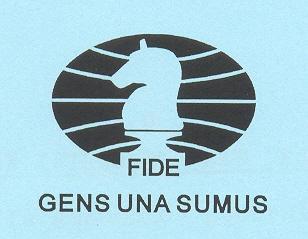
In an unexpected written statement to the members of the General Assembly the President of the International Chess Federation announced, as he approached the end of his term of office, that he had decided not to stand for re-election. He also advocated a revision of the rules so that no future President could serve more than one term. In his view, even if such a provision were not introduced it should be observed in practice.
In the long run, he declared, every political programme became conservative because it could not change direction without being weakened. ‘From time to time it is therefore a good policy ... to replace the leaders by others who have new ideas and new possibilities.’ The FIDE President’s announcement concluded by inviting the General Assembly to choose as his replacement an independent figure who was wise, patient and knowledgeable (about people and things).
This statement was made, we omitted to mention, in June 1928. The Dutchman Alexander Rueb had become President four years previously, but now a range of considerations (including ill-health and a declared desire to spend more time at the chess board) had decided him to stand down. It was not to be. The 1928 Congress in The Hague declined his resignation, and Rueb agreed to carry on. He remained President for another two decades.
The source of Rueb’s statement is FIDE’s minutes and other documentation regarding the 1928 General Assembly. The following year, for the Federation’s Congress in Venice, Rueb wrote an account of the period 1928-29 in which he referred to his resignation having been rejected and thanked the General Assembly for its expression of confidence in him. (‘Le Congrès de La Haye ayant nettement refusé d’agréer la démission du Président de la FIDE, il appartient à celui-ci d’exprimer ses remerciements émus à l’Assemblée générale pour cette nouvelle preuve de confiance ...’) Source: the minutes of the General Assembly in Venice, page 2.
‘FIDE was founded in 1924’ say the history books, yet, technically speaking, that could be disputed. Certainly the Fédération Internationale des Echecs was formed that year, but its Statutes systematically referred to it as ‘FIE’, and not ‘FIDE’:
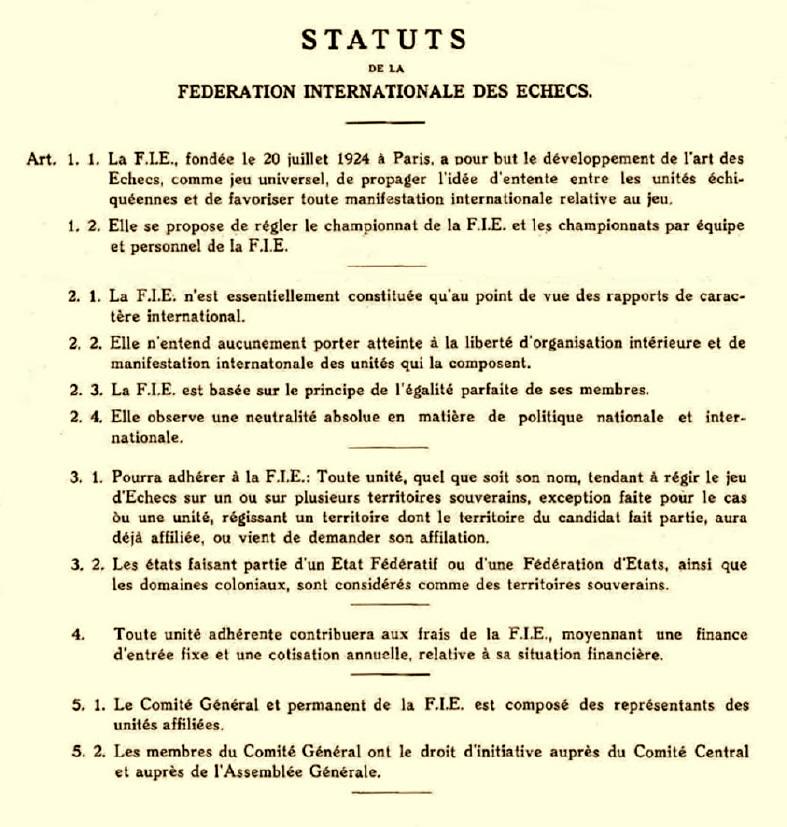
The original (1924) version of the Federation’s Statutes. They were amended the following year.
Throughout the initial period ‘FIE’ was the name also used in other official documents and in press reports; see, for instance, page 149 of the September 1924 Schweizerische Schachzeitung (a report by Marc Nicolet, the Federation’s Treasurer). In spring 1925 Rueb wrote to federations to communicate the programme for the second Congress (Zurich, July 1925), and in that document too ‘FIE’ was used. But later in the year, for reasons as yet unclarified, ‘FIDE’ became the official acronym. If ‘FIDE’ appeared in print in 1924, we have yet to find it.
Page 24 of the 1973 book Primera Olimpíada de Ajedrez by M.A. Lachaga quoted the October 1949 issue of L’Italia Scacchistica as stating that ‘FIDE’ was proposed by the Italian chess official Alberto Fidi and that Pierre Vincent had remarked, ‘FIDE was christened by Italy’.
In Paris in 1924 Rueb took the post of President only until the Zurich Congress, which also amended the Statutes of the re-christened FIDE. This instability suggests that the Federation’s foundation in 1924 had been rushed, and such was the case. It was not until its April 1924 issue (page 93) that La Stratégie had a brief news item inviting national federations to participate in, and to put forward views about, the planned Paris meeting, at which the creation of an international chess federation would be proposed by France:
‘Le Comité organisateur du Tournoi international d’amateurs qui doit se jouer à Paris du 13 au 20 juillet prochain invite les Fédérations étrangères à venir assister à un Congrès le dimanche 20 juillet et les prie de lui faire parvenir à ce sujet leur avis sur l’opportunité de ce congrès et les différents sujets qui pourraient y être traités.
En premier lieu, la Fédération Française des Echecs proposerait la constitution d’une Fédération internationale des Echecs.
Adresser toute la correspondance à M. Fernand Gavarry, ministre plénipotentiaire, président du Comité, 14 rue Alfred-de-Vigny, à Paris (VIIIe).’

F. Gavarry
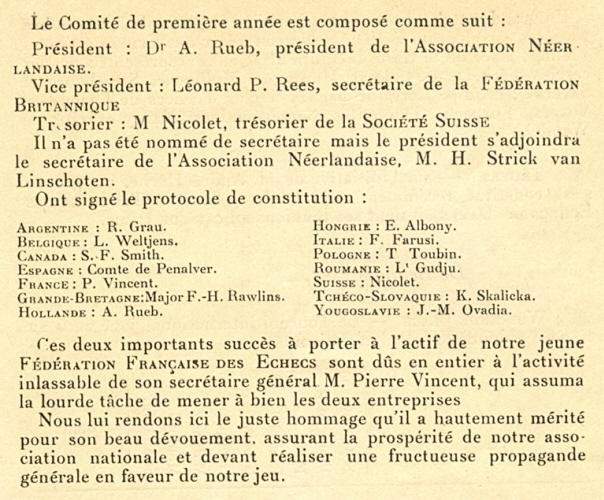
Page 201 of the August 1924 issue of La Stratégie (see above) stated that the success of creating the international federation and having 14 countries sign its draft constitution was entirely due to the work of Pierre Vincent, the Secrétaire général of the French Chess Federation. Vincent is regarded as the founder of the International Chess Federation (see, for instance, page 9 of the 1977 publication Livre d’or de la FIDE), yet few chess reference books say anything about him.

The above photograph of Pierre Vincent (1878-1956) comes from the January 1926 issue of L’Echiquier.
For earlier (1914 and 1920) initiatives to create an
international body, see pages 129-130 of Chess Explorations.
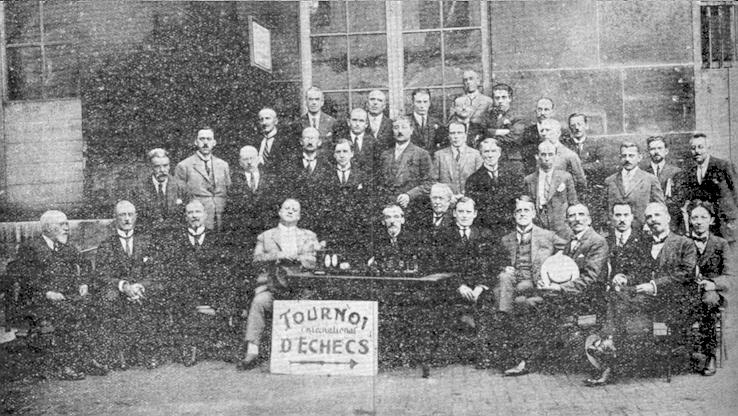
Paris, 1924. A. Rueb is seated
fifth from the right, with A. Alekhine on his right
The lack of proper planning for the Paris meeting was mentioned by Léon Weltjens of the Belgian Chess Federation in a detailed article about the 1925 Congress in Zurich (L’Echiquier, July 1925, pages 129-132). Weltjens, who had signed the draft constitution for his country, stated that the creation of the international body the previous year had been ‘le résultat d’un moment d’enthousiasme’. In Paris, he wrote, a temporary administration had been set up within just a few minutes, the entire project had been a step into the unknown, the key decisions had been left for the 1925 Congress, and it was now unclear what would remain of the initial excitement. (‘En quelques minutes un bureau provisoire fut formé, et l’on se donna rendez-vous à l’année suivante. L’année suivante, c’était la grande inconnue. Que serait-il resté de l’engouement du premier moment?’)
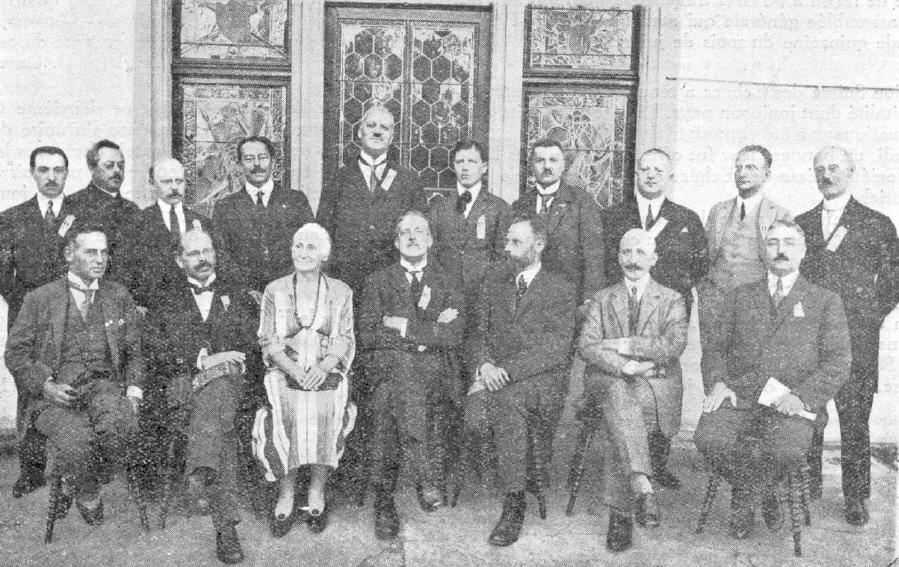
Zurich, 1925
Seated (left to right): V.L. Wahltuch, M. Nicolet, Mrs S.J.
Holloway, A. Rueb, E. Müller, W. Robinow, P. Vincent.
Standing: A. Fidi, C. de Roche, L. Weltjens, E. St John Mildmay,
L. Miliani, I. Gudju, H. Römmig, S. Abonyi, K. de Watteville,
S.J. Holloway
Weltjens also reported in his article in L’Echiquier that the results of the Zurich Congress surpassed expectations and had placed FIDE on a sound footing. Nine Member Federations (or ‘units’ as they were termed) were present. It was agreed that supreme power in FIDE would be vested in the General Committee, which comprised the representatives of the ‘affiliated units’. Management of the Federation was entrusted to a three-member Central Committee: a President, Vice-President and Treasurer of different nationalities. The outgoing post-holders who had taken office provisionally in 1924 (Alexander Rueb of the Netherlands, Leonard Rees of Great Britain and Marc Nicolet of Switzerland) were re-elected by the 1925 General Assembly for three years, by acclamation. Future terms of office, it was decided, would be two years.
At FIDE’s Congress in Hamburg in 1930, however, the Statutes were amended so that elections for the posts of President, Vice-President and Treasurer would take place every four years. Rueb was re-elected in Paris, 1932 and Lucerne, 1936. Because of the War, the next FIDE Congress at which the issue of the Presidency arose was in 1946, in Winterthur. (See pages 91-92 of Chess Facts and Fables and, for a group photograph, C.N. 3821.) Rueb was re-elected yet again, but at the 1948 Congress in Saltsjöbaden he announced his intention of stepping down.
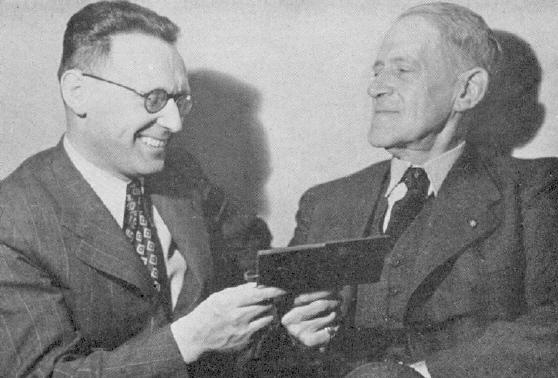
M. Botvinnik and A. Rueb in 1948
At the proposal of Folke Rogard, a Vice-President from Sweden, it was agreed at the 1948 Congress that Rueb would continue in office until the following year, and at the 1949 General Assembly in Paris Rogard was elected President almost unanimously. Rueb, who had headed the Federation for a quarter of a century, became Honorary President. He died in 1959 at the age of 76.
In C.N.s 879, 942 and 961 (see page 189 of Chess Explorations) readers discussed when FIDE began using Gens una sumus. The earliest instance found was surprisingly late (FIDE Revue, 1952), and no further information has yet come to our notice. Moreover, details are still lacking as to who decided, and when, that the Federation would adopt the Latin motto.
Jonathan Hinton (East Horsley, England) points out the following paragraph on page 197 of The World of Chess by A. Saidy and N. Lessing (New York, 1974):
‘“The Screw” – Screw the piece firmly into the square. This gives the impression of great scientific solidity. Practiced by World Champion Smyslov.’
From Bernd Graefrath (Mülheim/Ruhr, Germany):
‘On page 332 of Chess Facts and Fables a correspondent of yours refers to Karl Eisenbach (1836-1894) and gives a quotation from page 111 of the March-April 1908 Wiener Schachzeitung which claimed that he had formulated the principle about the threat being stronger than the execution.
I would add that the point was made again on page 151 of the May-June 1908 issue:
“Wichtiger als die vorgeführten Details ist aber die Tatsache, daß auch hier das Eisenbachsche Prinzip sich bewährt: ‘Die Drohung ist oft stärker als die Ausführung’.”
Eisenbach was also quoted on another matter in a note on pages 57-58 of the March-April 1915 Wiener Schachzeitung:
“Karl Eisenbach, einer der feinsten Wiener Schachkenner, pflegte zu sagen: es gibt für einen weißen Springer in der Eröffnung keinen ungünstigeren Platz als b3 und für den schwarzen keinen schlechteren als b6.”
This principle about b3/b6 being bad squares for the knight is familiar from page 315 of Das Schachspiel by Siegbert Tarrasch (Berlin, 1931):
“Ebenso ist nach meiner Erfahrung ein weißer Springer auf b3, ein schwarzer auf b6 meist schlecht postiert.”
The English translation on page 222 of The Game of Chess (London, 1935) was:
“In the same way, it has been my experience that a knight at QKt3 is usually badly placed.”.’
Below is the entry for ‘Remismonde’ on page 171 of Dictionary of Modern Chess by Byrne J. Horton (New York, 1959). Any information confirming, refuting or complementing the entry will be gratefully received.
‘A term coined by Dr Tarrasch (1862-1934) which he applied to [Carl] Schlechter of Vienna. Schlechter was known to have terminated many of his games as drawn games. Hence, Dr Tarrasch referred to him as the “Master of the Vienna Remismonde”.
Literally, “Remismonde” is a compound French word. Remis in chess terminology means a draw. (See Dictionnaire de la Langue Française, by E. Littré, Paris, 1883.) Monde means world. There is no completely satisfactory or precise explanation of this compounded word. Dr Felix Pollak of Northwestern University, a passionate chessplayer from Vienna, offered the following explanation. He wrote: “I believe it is simply a play on words, coining a parallel expression to ‘demi-monde’ (denoting a lady of the ‘half-world’ i.e. of easy virtue). Hence, calling Schlechter the Master of the Remismonde denotes Schlechter to be king of the drawing world, the Master of the Vienna ‘Grand-Master-Drawers’.” Mr Hans Kmoch, the renowned Secretary and Manager of the famous Manhattan Chess Club, concurs with this explanation.’
What do the following games have in common?
Marshall v Capablanca, seventh match game, 1909
Janowsky v Capablanca, Havana, 1913
Capablanca v Znosko-Borovsky, St Petersburg, 1913
Lasker v Capablanca, St Petersburg, 1914
Chajes v Capablanca, New York, 1916
Capablanca v Marshall, St Petersburg, 1914
Capablanca v Chajes, New York, 1918
Morrison v Capablanca, New York, 1918
Marshall v Capablanca, New York, 1918.
The answer is that all of them were annotated in depth by Capablanca in the ‘Illustrative Games’ section of Chess Fundamentals and all of them have been chopped out of the ‘completely revised & updated’ edition by Nick de Firmian (Random House, New York, 2006). Their removal makes space for some newer games, including five and a half pages devoted to N. de Firmian v P. Youngworth, Lone Pine, 1980.
We hope that anyone who chooses to sell the book will at least warn prospective purchasers about what Mr de Firmian has done, the above being, alas, just one example.

We are still awaiting readers’ proposals for the first appearance of the exact terms ‘world [chess] champion’ and ‘[chess] champion of the world’. In the meantime, Robert John McCrary (Columbia, SC, USA) has submitted the following from Richard Lambe’s The History of Chess (London, 1764):
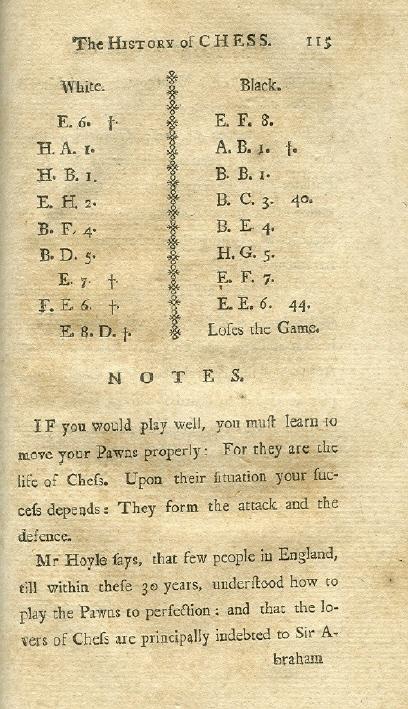
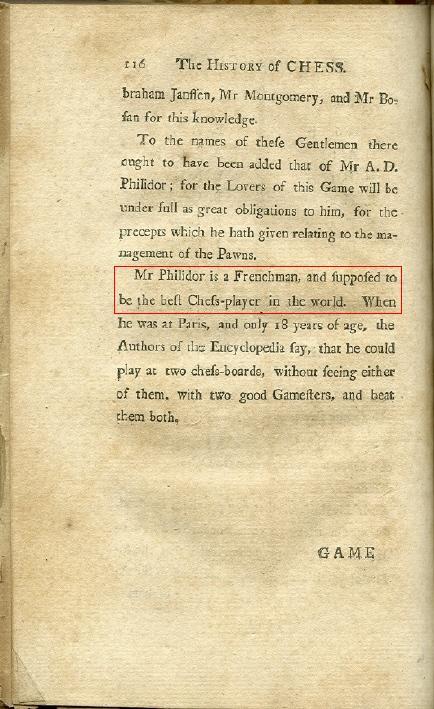
Which chess master is supposed to be depicted in the sketch below?
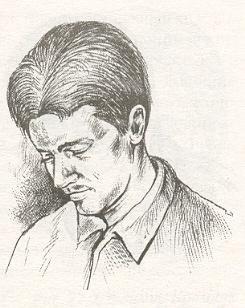
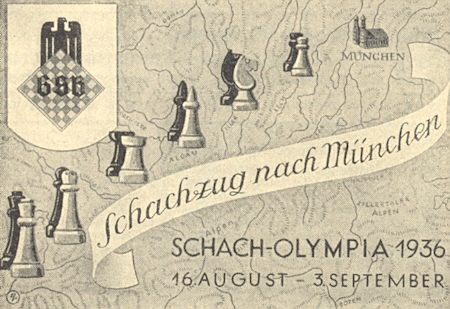
Seventy years ago a chess Olympiad was held in Munich, although Germany was not a member of FIDE at the time. Page 546 of the November 1936 BCM commented:
‘All accounts to hand bear witness to the very efficient management of the International Team Tournament at Munich. ... When then shall we hear of the re-entry of Germany into the International Chess Federation? It is difficult to understand why Germany withdrew; for it was, of course, a case of withdrawal, not of expulsion. The virus of politics is indeed potent if it prevents both Germany and Russia making FIDE truly what its name claims to be.’
FIDE’s position regarding the Munich Olympiad was set out on pages 10-11 of the minutes of its Congress in Warsaw in August 1935:
‘Le Grossdeutscher Schachbund a sollicité la collaboration de la FIDE en vue de l’organisation des épreuves internationales en Allemagne 1936 à l’occasion de la XIe Olympiade. Le GDSB a déclaré que le paragraphe arien sera supprimé pour toutes les équipes participantes.
Le Président donne un exposé de la situation. Le GDSB désire se rapprocher de la Fédération Internationale et si cette éventualité est impossible, il désire une collaboration afin de se servir de l’intermédiaire de la FIDE pour les invitations et l’organisation des tournois mentionnés.
La résolution suivante est adoptée à ce sujet par 10 oui, 5 abstentions, 2 non.
“L’Assemblée Générale prend en considération la requête du GDSB. Elle apprécie la bonne volonté du GDSB de vouloir se présenter éventuellement comme membre de la FIDE; elle regrette que provisoirement cette éventualité ne paraisse pas réalisable par suite de l’introduction dans ses statuts d’éléments qui n’ont pas trait au jeu d’échecs; ces éléments sont jugés opposés au caractère et aux Statuts de la FIDE.
L’Assemblée Générale regrette par conséquent que le GDSB se trouve dans l’impossibilité de s’occuper des intérêts de la FIDE, mais elle apprécie ses efforts pour le développement du jeu dans le domaine international.
Le GDSB s’est engagé formellement à ce que le paragraphe incriminé de ses statuts soit supprimé pour toutes les équipes (l’équipe allemande incluse) lors des tournois proposés pour 1936, ainsi que pour l’organisation de tout autre tournoi par équipes du GDSB et de ses divisions contre les équipes d’une fédération étrangère.
Dans l’expectative de l’exécution effective de cet engagement de la part du GDSB, l’Assemblée Générale de la FIDE laisse à ses fédérations affiliées toute liberté de s’inscrire au tournoi des nations du GDSB 1936.”’
In short, given that parts of the German Chess Federation’s statutes were anti-Semitic, FIDE could have no involvement in the Munich Olympiad. However, since Germany had agreed, for that event, to drop its ban on Jews, FIDE’s General Assembly voted to leave Federations free to decide whether or not to participate.
In all, 21 countries played in Munich, and since photographs of the Olympiad are seldom seen nowadays (and, indeed, were quite scarce at the time, outside of Germany), we have put together a pictorial overview of the event.
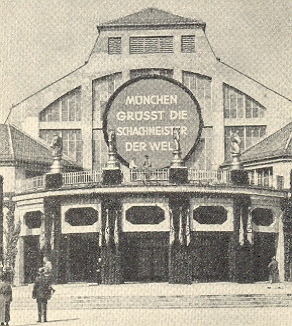
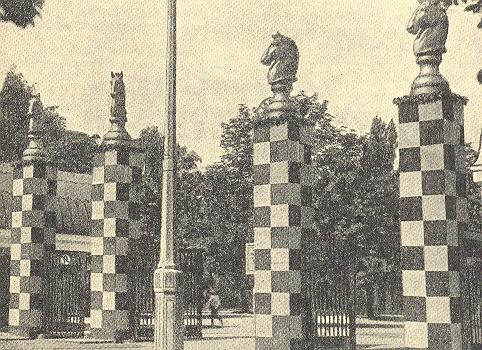

Government reception for participants, at the Nymphenburg Palace, Munich
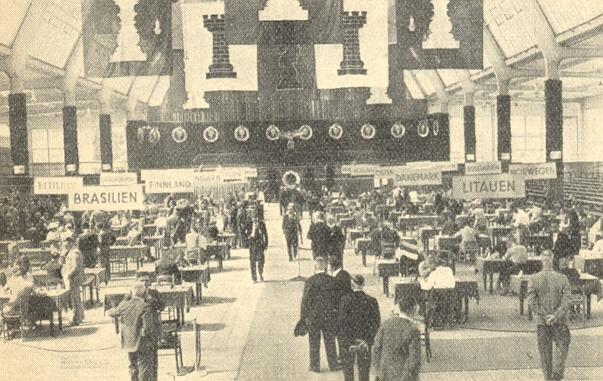

L. Engels, watched by O. Zander

P. Keres and V. Pirc
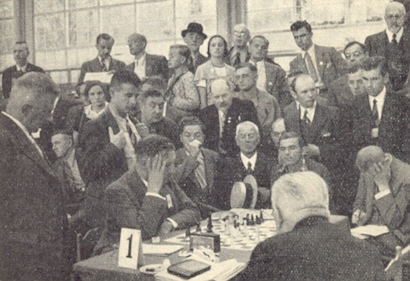
O. Naegeli
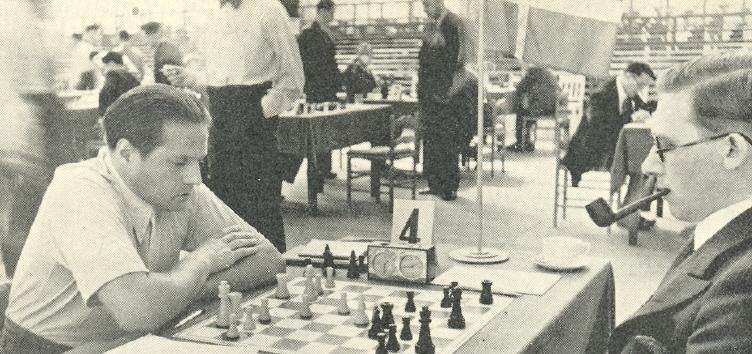
H. Müller and J. Nielsen
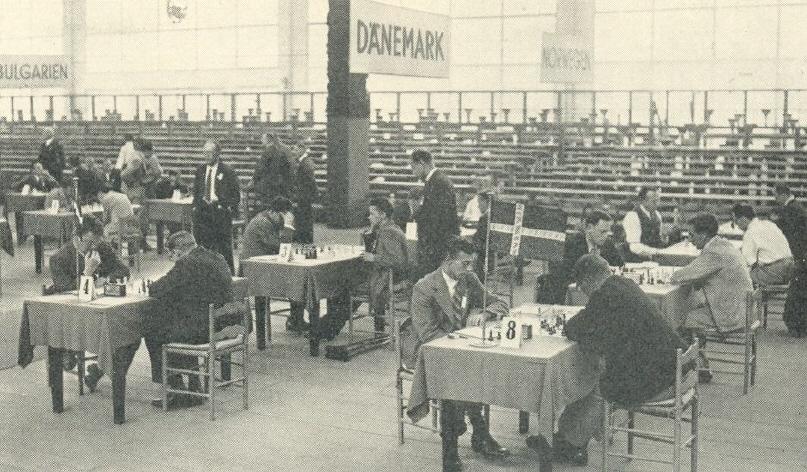
Denmark v Norway

‘Das Hans-Sachs Ballett’
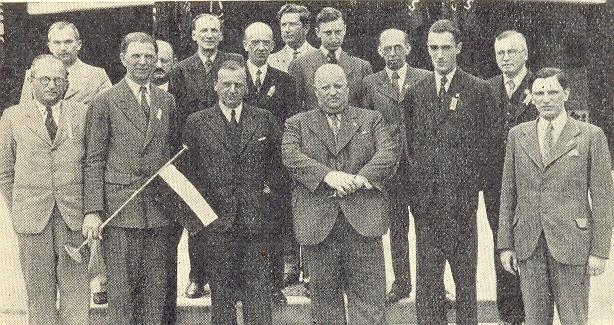
Hungary (first). Front (from left
to right): E. Steiner, G. Maróczy, N.N., S. Abonyi, G. Barcza,
I. Koródy
Behind: L. Steiner, A. Vajda, N.N., N.N., N.N., L. Szabó, A.
Havasi, J. Balogh.
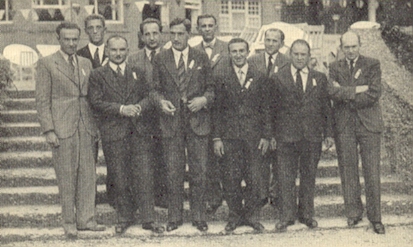
Poland (second). Left to right: H. Pogorieły, F. Sulik, K. Makarczyk, P. Frydman, T. Regedziński, A. Wojciechowski, M. Najdorf, J. Jagielski, L. Kremer, H. Friedmann
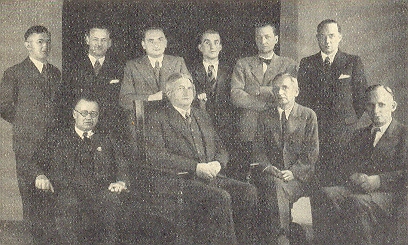
Germany (third). Seated (left to
right): L. Rellstab, C. Carls, C. Ahues, K. Richter
Standing: P. Michel, F. Sämisch, L. Rödl, L. Engels, H.
Heinicke, W. Ernst
The photographs are reproduced from the 1936 Deutsche Schachblätter, Kurt Richter’s two-volume work Schach-Olympia München 1936 (published in Berlin and Leipzig in 1936 and 1937) and Alt om Skak by B. Nielsen (Odense, 1943). Olympische Blitzsiege by E.J. Diemer (Kecskemét, undated) had 189 games from the Olympiad but no illustrations. A useful modern book is Munich ‘Olympiad’ 1936 edited by A.J. Gillam (Nottingham, 2000), which contains 612 games and game fragments. Some information on the political background to the event can be found in Schach unterm Hakenkreuz by Ralf Woelk (Pfullingen, 1996).
Our copy of 125 Jahre Münchener Schachclub 1836-1961 (Munich, 1961) has two chess bookplates on the inside front page (of James E. Gates and Gustav Karpati):
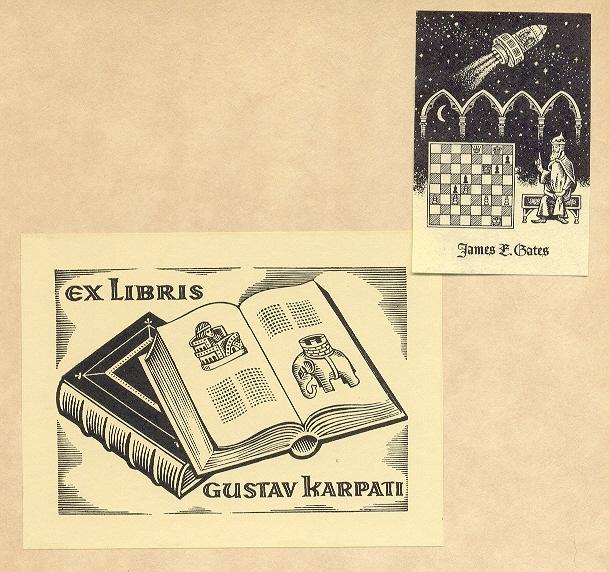
Page 13 of the book about the Munich Chess Club mentioned in the previous item has a photograph showing the 16-year Wolfgang Unzicker (far right) in play against Alekhine in Munich, 1941:
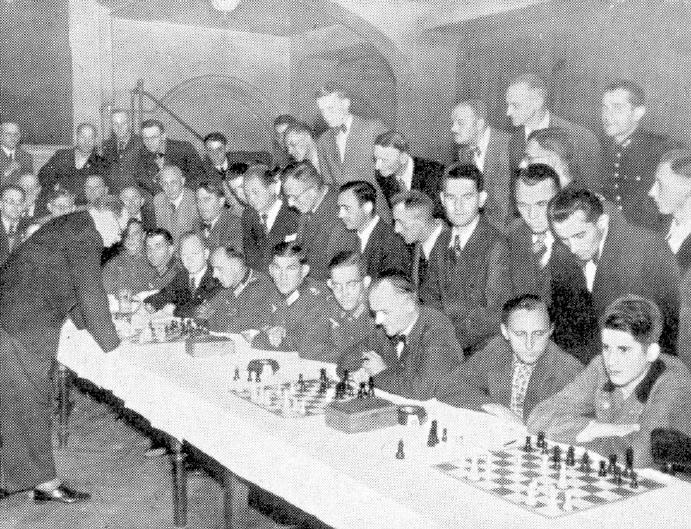
C.N. 4353 referred to the Belgian player Marcel Defosse, who co-authored with Frits van Seters Le jeu d’échecs (Brussels, 1944). Luc Winants (Boirs, Belgium) points out that Defosse was more famous under the name Denis Marion.
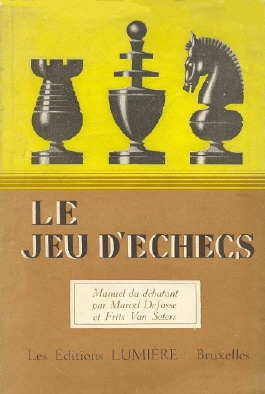
From Alan O’Brien (Mitcham, England):
‘You have mentioned in the past some books which have been badly updated. A volume which I think was updated extremely well is Charles Devidé’s A Memorial to William Steinitz, originally published in 1901. Dover reissued it in 1974 as William Steinitz Selected Games, with a new preface by David Hooper and six additional games annotated by him.
Those extra games were added with great care. An attempt was clearly made to match the typeface of Devidé’s original, quaint notation such as “Castles” was kept and the notes appeared in (a), (b), (c) style at the end of the game.
Hooper occasionally made changes to Devidé’s annotations. One example is on page 57, Steinitz v Labatt. The last note, in slightly darker print, adds “26 BxR, ch K to B1 27 B to Kt 7, mate”.
One change which Hooper did not make is on page 6, line 11, where the famous remark about Steinitz “This little man has taught us all how to play chess” was ascribed to Adolph “Schway” (at the Vienna, 1882 tournament), instead of Adolph Schwarz.’
Regarding that quotation, we add that on page 3 of his 1968 book on Steinitz in the Wildhagen series Hooper noted that the description of Steinitz (‘Der kleine Mann, der uns alle lehrte, wie man Schach spielen muß’ was attributed to Schwarz (‘A. Schwarz, 1882 zugeschr.’).
The Dover edition was entitled William Steinitz Selected Chess Games on the front cover, but the title-page omitted the word ‘Chess’.
About Charles Devidé little factual information seems currently available. Gaige’s Chess Personalia stated that he was born in Vienna on 22 February 1856 and died, possibly in New York, circa 1940. This means that he was nearly 80 when he wrote the last material we recall seeing from his pen: a brief article on the quantity of draws in world championship matches on page 168 of the November 1935 American Chess Bulletin. Devidé’s exacting conclusion was:
‘To make championship matches less tedious, let the contenders take matters less easy. There’s no reason why they should not play seven or eight hours a day, six play-days a week. They would have to do so in a tournament.’
C.N. 3239 (see page 250 of Chess, Facts and Fables) referred to an alleged illustration of Ruy López on page 82 of Historia general del ajedrez by Julio Ganzo (third edition, Madrid, 1973):
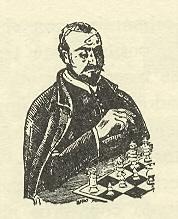
We asked if it had an historical basis, a question yet to be resolved. We can, though, add that the following appeared in the first plates section of Şah de la A la Z by Constantin Ştefaniu (Bucharest, 1984):
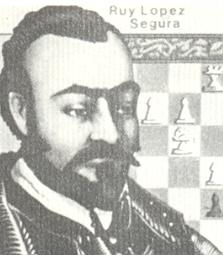
Moreover, it may be recalled that a similar illustration was on a Cuban postage stamp in 1976. The picture may be contrasted with what appeared on a stamp issued by Guinea Bissau in 1988.
What is the original source of these depictions of Ruy López?
Peter Anderberg (Harmstorf, Germany) writes:
‘Tony Gillam gave nearly 60 additional games and game fragments in the Quarterly for Chess History, 7/2001, pages 247-263. “Nearly” as there are some duplicates with the games in his book on Munich, 1936. I am preparing a collection of around 20 additional games taken from German newspapers of the time.’
C.N.s 3574, 3676 and 4133 discussed the contradictory claims as to who made the remark about chess being too much of a game to be a science and too much of a science to be a game. Here it may be added that page 316 of volume one of Chess, Jews and History by Victor Keats (Oxford, 1994) has the following regarding Moses Mendelssohn:
‘Mendelssohn is said to have remarked that chess was too serious to be a game and too much of a game to be serious, but from what we have seen, he himself was inclined to disregard this maxim.’
A footnote on the same page reads:
‘See e.g. L. Dukes in Ben Chananja, 7 (1864), page 636; the same remark is also attributed to Montaigne.’
We therefore add here a note regarding Montaigne. The relevant passage occurs in his essay ‘De Democritus et Heraclitus’, which is Chapter L of his Essais. Below is the text as it appears on page 541 of volume one of the ‘Classiques de poche’ series (Paris, 2002), i.e. with modernized spelling but no grammatical changes:
‘Pourquoi ne jugerais-je d’Alexandre à table devisant et buvant d’autant? Ou s’il maniait des échecs, quelle corde de son esprit, ne touche et n’emploie ce niais et puéril jeu? Je le hais et fuis, de ce qu’il n’est pas assez jeu, et qu’il nous ébat trop sérieusement; ayant honte d’y fournir l’attention qui suffirait à quelque bonne chose.’
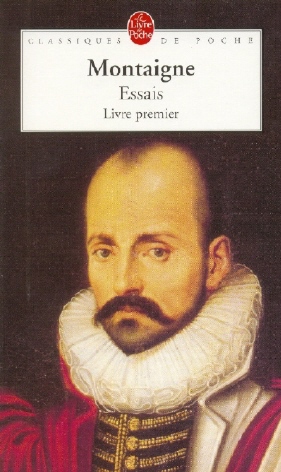
An English version of the maxim was given on page 21 of Chess Pieces by Norman Knight (London, 1949), and page 123 had other remarks on chess by Montaigne.
C.N. 4368 mentioned that the excision of nine games annotated by Capablanca was just one example of what Nick de Firmian had done to Chess Fundamentals in the 2006 edition issued by Random House, New York. We now give further examples.
In his Introduction (page vii) de Firmian explains the philosophy behind the butchery:
‘New concepts, new strategies, and even new chess notation make for a need to revise this classic for the 21st century.’
This disregards the fact that an algebraic edition already exists, published by Cadogan Chess in 1994. Since it presented the integral text in a mere 121 pages, why would any other algebraic edition, even if needed, have to save space by omitting reams of Capablanca’s material?
De Firmian also writes on page vii:
‘I have endeavored to replicate the care that went in to the 1921 version, with the intention to make a work with which Capablanca would be happy.’
He has done nothing of the kind, and Capablanca would obviously be devastated. In the 1934 Preface to the US version he wrote:
‘... Chess Fundamentals is as good now as it was 13 years ago. It will be as good a hundred years from now; as long in fact as the laws and rules of the game remain what they are at present. The reader may therefore go over the contents of the book with the assurance that there is in it everything he needs, and that there is nothing to be added and nothing to be changed. Chess Fundamentals was the one standard work of its kind 13 years ago and the author firmly believes that it is the one standard work of its kind now.’
De Firmian’s Introduction also summarizes some of the changes made (e.g. ‘Chapter 5, Openings, is completely new’) and says bizarrely about the book as a whole:
‘The chess historian should have little trouble deciphering which material is original if he or she is observant.’
This ‘he or she’ stuff, incidentally, is de Firmian’s preferred usage, and he foists it on Capablanca throughout. The first sentence in the first chapter of the first part of the original Chess Fundamentals stated: ‘The first thing a student should do, is to familiarise himself with the power of the pieces.’ De Firmian puts instead: ‘The first thing a student should do is to familiarize himself or herself with the power of the pieces.’ Correcting or amending Capablanca on matters large and small is such a thrill that de Firmian becomes unstoppable. Three times on pages 103-115 he alters ‘Kupchik’ to ‘Kupchick’, even though Capablanca’s spelling of the name was right. It is unfortunate that nobody was engaged by Random House to correct de Firmian. For instance, his ‘completely new’ 17-page chapter on the openings includes, on page 79, references to the ‘Four Knight’s Game’ and the ‘Two Knight’s Defense’. At no stage does de Firmian evince any knowledge of Capablanca’s career or games, and on page 14 he even goes wrong with a famous pawn ending presented by Capablanca. (See pages 319-320 of Kings, Commoners and Knaves and C.N. 3830.)
Beyond issues of arrogance and ignorance, the remaining question is whether de Firmian’s book attempts to deceive readers over the nature and extent of the alterations made. His Introduction (pages vii-viii) has a 17-line section entitled ‘What has changed from the original version’ in which he writes regarding the ‘illustrated [sic] games’ section:
‘Here we start with five of Capablanca’s original games (the most instructive ones in my opinion). After this, there are nine games from his time up to the present.’
How many readers would imagine from such a wording that Chess Fundamentals originally contained 14 illustrative games annotated by Capablanca and that de Firmian has eradicated all but five of them?
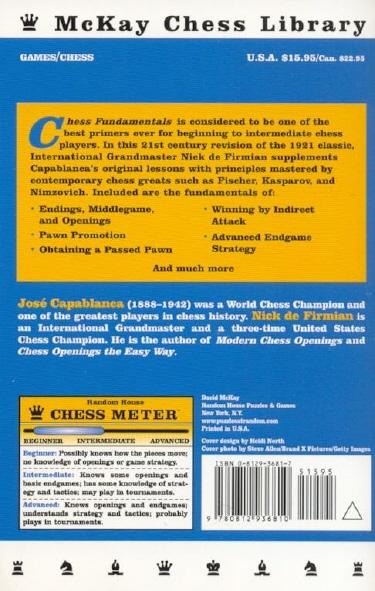
Publishers know that indolent and/or time-pressed vendors often make do with quoting from the back-cover blurb. As shown above, the Random House book states:
‘... de Firmian supplements Capablanca’s original lessons with principles mastered by contemporary chess greats such as Fischer, Kasparov, and Nimzovich.’
The presence of Nimzowitsch’s name is inexplicable, but the damning, deceitful word is ‘supplements’. De Firmian has not supplemented Chess Fundamentals. He has destroyed it.
From Norman Pillsbury (Atascadero, CA, USA):
‘I can shed a little light on the inscriptions, based on the 1898 book The Pillsbury Family by David B. Pilsbury and Emily A. Getchell. Page 162 gives the following information:
“Luther B. (Caleb, Caleb), b. 23 Nov. 1832; m. 14 Aug 1863, Mary A. Leath, of Lynnfield, Mass., who d. in Somerville, 20 Nov. 1888, aged 50. Children:
i. Edwin B., b. in Hopkinton, N.H., 30 Aug. 1866
ii. Ernest D., b. in Hopkinton, N.H., 19 May 1868
iii. May F., b. in Bridgewater, 15 May 1870
iv. Harry N., b. in Somerville, 5 Dec. 1872.”’
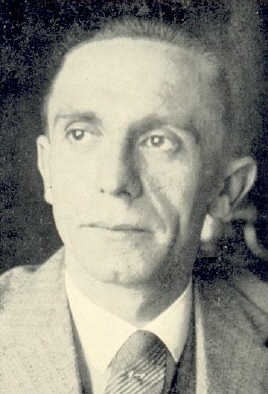
Joseph Goebbels
From page 659 of Alexander Alekhine’s Chess Games, 1902-1946 by L.M. Skinner and R.G.P. Verhoeven (Jefferson, 1998) comes this passage concerning Munich, 1941:
‘The tournament started on 8 September ... A large reception was held on the evening of the first day. This was attended by leading lights from the Nazi Party, the State Government and the Wehrmacht. ... The Chief Executive of the Großdeutscher Schachbund, Ehrhardt Post, spoke on the importance of forming a new chess organization ... In his speech, he also acknowledged the debt due to the two Reichsministers present, Dr Josef Goebbels and Dr Hans Frank, for their generous support of the tournament.’
See also page 150 of Deutsche Schachblätter, 1 October 1941. Did any German newspapers of the time have photographs of, or reports on, the reception?
From Christian Sánchez (Rosario, Argentina):
‘C.N. 4309 asked when the wrong position from Flohr v Grob first appeared in print and referred to “a Russian brochure by Boris Wainstein”. The position in question was given on pages 53-55 of Wainstein’s book Kombinatsii i lovushki v debyute (Moscow, 1965). See also pages 52-53 of the Spanish translation, La trampa en la apertura (Barcelona, 1967).
Wainstein (or Weinstein) states that the story had appeared previously, told by Ferzberi (i.e. Wainstein himself). It is essentially the same as Gerald Abrahams’ version, with the addition of Bronstein as the master who found the winning line for Black and told Flohr.’
A game before us now in a nineteenth-century chess magazine is headed ‘Popcorn Opening’. What were the first moves?
In a review of Chess Facts and Fables on pages 59-60 of the June 2006 CHESS C. Ravilious proposes one factual correction: on page 375 the index entry ‘Lyttelton, Lord George Williams’ should be ‘Lyttelton, Lord George William’. We followed Jeremy Gaige’s A Catalog of Chessplayers & Problemists (1971) and Chess Personalia (1987) but, no longer at all sure, we shall look into the matter. Mr Ravilious’ review also mentions that A Chess Omnibus has, on page 466, ‘Thackeray, William Makepiece’, instead of (as given in the body of the book) ‘Makepeace’.

Jerry Spinrad (Nashville, TN, USA) provides some old newspaper reports about the girl prodigy Celia Neimark, who was discussed on pages 79-80 of A Chess Omnibus. These include references to performances by her in simultaneous chess, one example coming from page 23 of the New York Times, 8 October 1921:
‘An exhibition of simultaneous play by Celia Neimark, seven-year-old girl player from West Austintown, Ohio, resulted in her making a score of three victories, one defeat and two drawn games after playing for one hour. Adjudications were made by Edward Lasker, Western champion.’
The Washington Post, 6 November 1921, page 85 had the same photograph of Celia Neimark as given above (from our Chess Prodigies feature article). The newspaper added that she was the ‘daughter of a farmer living near Youngstown, Ohio’ and that ‘she first became interested in chess in February 1920’.
The score of a game by her – a win against Irving Spero – was presented on pages 79-80 of A Chess Omnibus, which noted that ‘her further exploits remain to be chronicled’. That is still the case, and an additional question arises: which other players aged seven or under have given simultaneous displays?
This familiar anecdote comes from pages 12-13 of The Bright Side of Chess by Irving Chernev (Philadelphia, 1948):

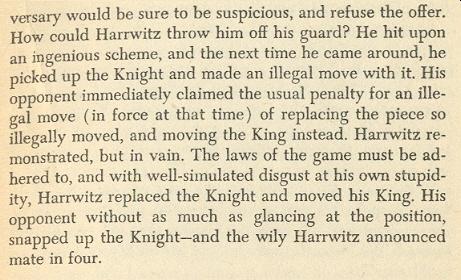
Chernev did not specify his source, but the story had appeared on page 25 of the Chess Player’s Chronicle, 24 June 1885 and on page 232 of the June 1885 BCM, with both magazines recording that, according to the Melbourne Leader, it had been related by Blackburne. See also page 222 of the November 1915 American Chess Bulletin. The wording is similar in all four cases.
We have not come across any publication of the tale during Harrwitz’s lifetime (he died in 1884) or any further information about the position in question. On the other hand, it may be recalled (see page 37 of Kings, Commoners and Knaves) that under the title ‘Skulduggery’ C.N. 2157 gave a position which had appeared in the Chess Weekly (19 December 1908, page 25):
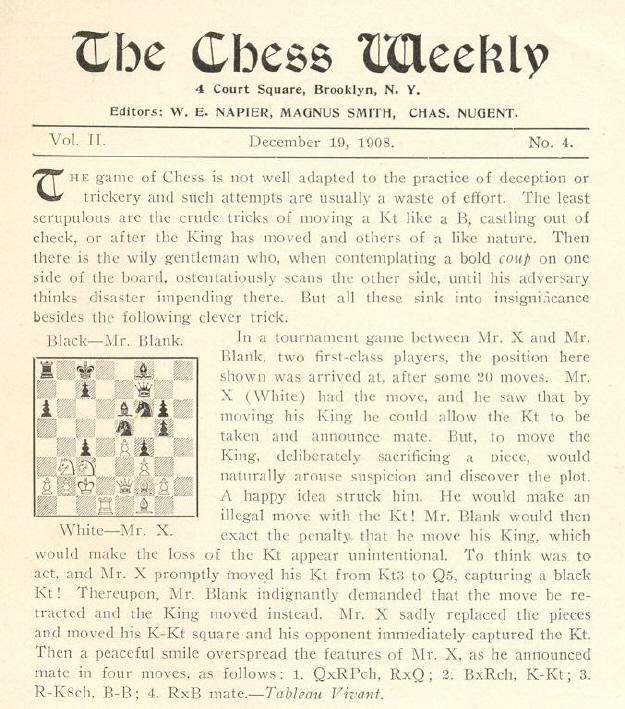
The over-the-board play corresponds perfectly to the Harrwitz story: White made an illegal move with a knight which was under attack by a pawn and, after moving his king as a penalty and having his knight captured, he announced mate in four. Can all this be a coincidence, or does a more complicated explanation exist?
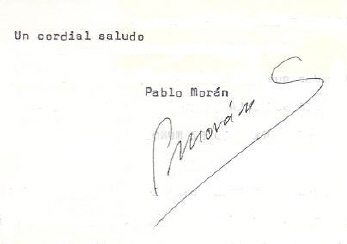 We have been
looking over our agreeable correspondence with the late Pablo
Morán. In one letter (undated but probably written in September
1977) he told us regarding his book Agonía de un Genio
that an English translation by Frank Mur was under way and that
the Spanish original was full of errors (‘como habrá comprobado
está repleto de errores’). On 17 June 1987 he mentioned that
the new edition would contain many corrections and important fresh
material (‘tendrá muchas mejoras respecto a la edición en
español, pues hemos corregido las erratas y mejorado mucho el
texto con nuevas partidas y descubrimientos importantes’).
One curiosity is that the following year Morán sent us a cutting
from El Correo de Asturias of 12 July 1988 which
announced his election as President of the Federación Asturiana de
Ajedrez. The newspaper added that his Alekhine book ‘ha sido
traducido recientemente al inglés y al ruso’. We recall no
other reference to a Russian translation.
We have been
looking over our agreeable correspondence with the late Pablo
Morán. In one letter (undated but probably written in September
1977) he told us regarding his book Agonía de un Genio
that an English translation by Frank Mur was under way and that
the Spanish original was full of errors (‘como habrá comprobado
está repleto de errores’). On 17 June 1987 he mentioned that
the new edition would contain many corrections and important fresh
material (‘tendrá muchas mejoras respecto a la edición en
español, pues hemos corregido las erratas y mejorado mucho el
texto con nuevas partidas y descubrimientos importantes’).
One curiosity is that the following year Morán sent us a cutting
from El Correo de Asturias of 12 July 1988 which
announced his election as President of the Federación Asturiana de
Ajedrez. The newspaper added that his Alekhine book ‘ha sido
traducido recientemente al inglés y al ruso’. We recall no
other reference to a Russian translation.
For the reasons set out in C.N.s 4016 and 4357 it now seems unlikely that the Spanish and English editions were right to state that the 15-move game under discussion was won by Alekhine against Muñoz at Sabadell, 1945, but can the facts be established beyond doubt? Two questions may be raised here:
1. Was the game published, by Morán or anyone else, before 1972?
2. What happened to Morán’s library and archives after his death on 25 November 1995 (as reported on pages 6-8 of issue 416 of Jaque, January 1996)?
It is surely high time that more was discovered about Francisco Lupi, a frequent opponent and companion of Alekhine during the world champion’s final phase. Readers’ help will be much appreciated.
Jeremy Gaige’s Chess Personalia gives no birth-date for Lupi, merely recording that he died in January 1954. On page 3 of A. Alekhine Agony of a Chess Genius (Jefferson, 1989) Pablo Morán wrote:
‘Francisco Lupi, Alekhine’s last serious opponent, was also his last friend. A noted Portuguese player, Lupi died in Madrid in 1954, scarcely past his prime. During the forties and early fifties, he played tournaments in Spain, a match in Zaragoza against Dr Rey Ardid and many simultaneous exhibitions.
I made his acquaintance in Gijón during the 1945 International Tournament ... In 1951, he befriended me in Madrid, after I had won a local tournament. Lupi was affable, cordial and refined. He possessed a notable chess talent, which I heard Alekhine praise more than once. But his health declined, and after the 1951 tournament he was confined to a sanitarium with a heart condition.
He talked much about Alekhine as we strolled through the Madrid streets, or had drinks in the “Bowery of Bilbao” cafés.’
From a photograph taken at Sabadell, 1945 (contributed by Miquel Artigas in C.N. 4008) we have extracted the following:
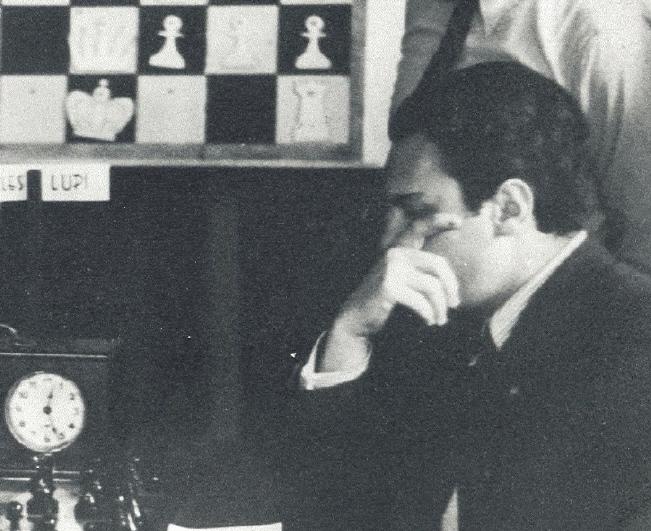
Francisco Lupi
A further picture of Lupi was given on page 66 of the London, 1946 tournament book (published by CHESS, Sutton Coldfield):

He also appeared in three group photographs (two of them featuring Alekhine) in Xeque-Mate no Estoril by Dagoberto L. Markl (Porto, 2001). If, as seems quite possible, Lupi was aged no more than about 30 when all the above-mentioned photographs were taken, that would mean that he died before he was even 40.
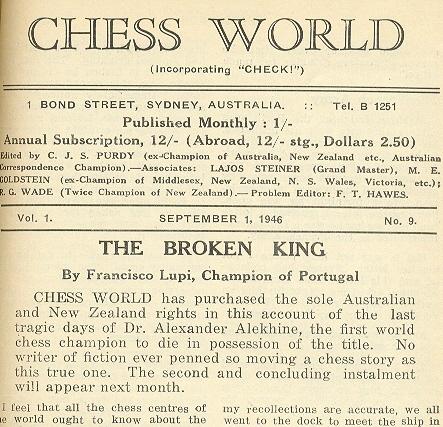
His prime contribution to chess literature was his celebrated two-part article ‘The Broken King’, the full text of which is included in Morán’s book. The English version was originally published in Chess World, 1 September 1946, pages 161-165 and 1 October 1946, pages 185-187. As may be seen above, the Editor, C.J.S. Purdy, accorded it high praise:
‘No writer of fiction ever penned so moving a chess story as this true one.’
Pictures of a chessboard with a black square at h1 are too frequent to be noteworthy, but a paragraph on page 71 of the December 1919 Chess Amateur may be quoted:
‘A reader asks: “Would you be kind enough to tell me why, in playing chess, the right-hand under corner square should show the white colour? I have seen text books stating that this is the rule – and I know it – but none explaining why. Would any inconvenience result from non-observation of this rule?” This is merely custom, just as in draughts a black square is at right lower corner. The effect of non-observance would merely be unfamiliarity – but it would in no way make any difference to the play.’
A much stranger occurrence, pointed out by Hassan Roger Sadeghi (Lausanne, Switzerland), is the front cover of L’oeil tactique: l’entraînement à la combinaison by Emmanuel Neiman (Paris, 2003):
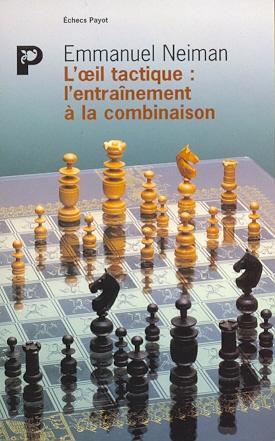
Chess Notes Archives:
| First column | << previous | Archives [22] | next >> | Current column |
Copyright 2006 Edward Winter. All rights reserved.